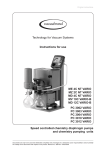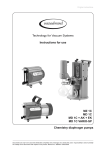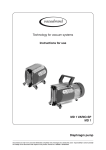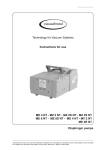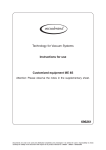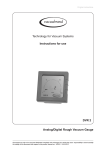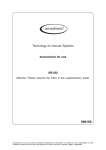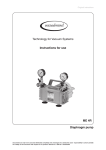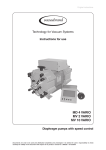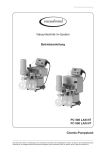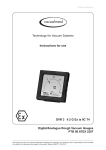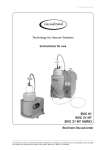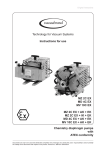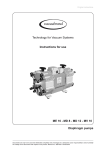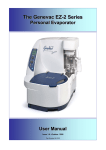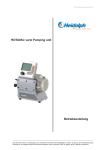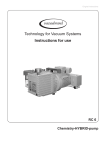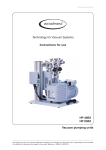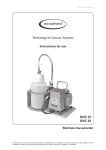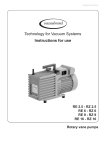Download Manual - Vacuubrand.com
Transcript
page 1 of 63 Technology for Vacuum Systems Instructions for use PC 510 NT / PC 511 NT / PC 520 NT PC 610 NT / PC 611 NT / PC 620 NT Chemistry pumping unit Documents are only to be used and distributed completely and unchanged. It is strictly the users´ responsibility to check carefully the validity of this document with respect to his product. Manual-no.: 999188 / 19/05/2009 page 2 of 63 Dear customer, Your VACUUBRAND diaphragm pumps should support you for many years without trouble and with optimal performance. Thanks to our long practical experience we have much information and advice on how you can achieve powerful application usage and personal safety through our products. Please read these instructions for use before the initial operation of your pump. VACUUBRAND diaphragm pumps are the result of many years of experience in design and construction and practical operation of these pumps combined with the latest developments in material and manufacturing technology. Our quality maxim is the „zero fault principle“: Every diaphragm pump leaving our company, is tested intensively including an endurance run of 18 hours. Therefore faults, even those which occur rarely, are identified and can be eliminated immediately. The achievement of the specifications after the endurance run is tested for every pump. Every VACUUBRAND pump achieves the specifications. We are committed to providing our customers with this high quality standard. We know that the vacuum pump cannot replace all of your real work and hope that our products contribute to an effective and trouble-free realisation of your work. Yours VACUUBRAND GMBH + CO KG After sales service: Contact your local dealer or call +49 9342 808-193. ➨ Danger! Immediate danger. Death or severe injuries as well as damage to equipment and environment can occur. ☞ Warning! Possible danger. Severe injuries as well as damage to equipment and environment can occur. • Caution! Possible danger. Slight injuries as well as damage to equipment and environment can occur. NOTICE Note. Disregarding of notes may cause damage to the product. Caution! Hot surface! Isolate equipment from mains before removing the cover. Documents are only to be used and distributed completely and unchanged. It is strictly the users´ responsibility to check carefully the validity of this document with respect to his product. Manual-no.: 999188 / 19/05/2009 page 3 of 63 Reset / Language selection 1 switch off 2 press both C V C 3000 3turn D eutsch E nglish Français Italiano E spañol Türkçe P ortuguê Ρ yccкий P olski N ederl. 日本語 한국어 中文 C V C 3000 4press V 2.0 D eutsch E nglish Français Italiano E spañol Türkçe V 2.0 Portuguê Ρyccкий Polski N ederl. 日本語 한국어 中文 Documents are only to be used and distributed completely and unchanged. It is strictly the users´ responsibility to check carefully the validity of this document with respect to his product. Manual-no.: 999188 / 19/05/2009 page 4 of 63 Contents Reset / Language selection......................................................................................3 Safety information!......................................................................................................5 General information.............................................................................................................................5 Intended use........................................................................................................................................5 Setting up and installing the equipment..............................................................................................5 Ambient conditions..............................................................................................................................6 Operating conditions...........................................................................................................................6 Safety during operation.......................................................................................................................7 Maintenance and repair.......................................................................................................................9 Technical data............................................................................................................10 Technical data controller................................................................................................................... 11 Gas inlet temperatures.....................................................................................................................12 Wetted parts.....................................................................................................................................12 Pump parts.......................................................................................................................................13 Use and operation.....................................................................................................17 Installing in a vacuum system...........................................................................................................17 During operation................................................................................................................................19 Attention: Important notes regarding the use of gas ballast..............................................................20 Shutdown..........................................................................................................................................21 Vacuum Controller CVC 3000...........................................................................................................22 Menu guide.................................................................................................................25 Function Pump down................................................................................................26 Function Vac control.................................................................................................27 Function Program......................................................................................................29 Example for use...............................................................................................................................30 Function VACUULAN................................................................................................31 Examples for use.......................................................................................................32 Vacuum for filtration and suction......................................................................................................32 Vacuum for gel dryer, drying chambers and vacuum concentrators....................................................32 Vacuum for distillation and evaporation (e. g. rotary evaporator).....................................................33 Vacuum for VACUU•LAN networks..................................................................................................33 Function Configuration.............................................................................................34 Readjustment of CVC 3000.......................................................................................35 Calibration in the factory..........................................................................................36 Interface parameters.................................................................................................36 Setting of the interface.....................................................................................................................36 Read commands ”CVC 2000”..........................................................................................................37 Write commands ”CVC 2000”..........................................................................................................38 Read commands ”CVC 3000”..........................................................................................................39 Write commands ”CVC 3000”..........................................................................................................42 Troubleshooting........................................................................................................44 Cleaning the pressure transducer...........................................................................47 Accessories...............................................................................................................48 Replacing diaphragms and valves..........................................................................49 Cleaning and inspecting the pump heads........................................................................................50 Replacing the diaphragm - PC 510/511/520 NT...............................................................................52 Replacing the valves - PC 510/511/520 NT......................................................................................53 Notes regarding replacing diaphragms and valves at PC 610/611/620 NT......................................57 Cleaning and assembling components...................................................................59 Notes on return to the factory..................................................................................60 Health and safety clearance form............................................................................61 Documents are only to be used and distributed completely and unchanged. It is strictly the users´ responsibility to check carefully the validity of this document with respect to his product. Manual-no.: 999188 / 19/05/2009 page 5 of 63 Safety information! General information NOTICE Read and comply with this manual before installing or operating the equipment. Transport the pump at the provided handle. Remove all packing material, remove the product from its packing-box, remove the protective covers from the inlet and outlet ports and keep, inspect the equipment. If the equipment is damaged, notify the supplier and the carrier in writing within three days; state the item number of the product together with the order number and the supplier’s invoice number. Retain all packing material for inspection. Do not use the equipment if it is damaged. If the equipment is not used immediately, replace the protective covers. Store the equipment in suitable conditions. Intended use ☞ The pump and all system parts must not be used on humans or animals. ☞ Prevent any part of the human body from coming in contact with vacuum. ☞ Ensure that the individual components are only connected, combined and operated according to their design and as indicated in the instructions for use. ☞Comply with notes on correct vacuum and electrical connections, see section ”Use and operation”. • The pumps are designed for ambient temperatures during operation between +10°C and +40°C. Check the maximum temperatures especially if installing the pump in a cabinet or a housing and make sure ventilation is adequate. Install an external automatic ventilation system if necessary. If pumping hot process gases make sure that the maximum permitted gas inlet temperature, which depends on several parameters like inlet pressure or ambient temperature (see ”Technical data”), is not exceeded. • Particles and dust must not be aspirated. NOTICE Use the equipment for the intended use only, i.e. for generation, control and measurement of vacuum in vessels designed for that purpose. Setting up and installing the equipment ➨ Equipment must be connected only to a suitably fused and protected electrical supply and a suitable earth point. Failure to connect the motor to ground may result in deadly electrical shock. The mains cable may be fitted with a moulded European IEC plug or a plug suitable for your local electrical supply. If the plug has been removed or has to be removed, the cable will contain wires colour coded as follows: green or green and yellow: earth; blue or white: neutral; brown or black: live. ☞ Due to the high compression ratio of the pump, the pressure at the outlet port might get higher than the maximum permissible pressure compatible with the mechanical stability of the system. ☞ Do not permit any uncontrolled pressurizing (e. g. make sure that the exhaust pipeline cannot become blocked). If there is an exhaust isolation valve, make sure that you cannot operate the equipment with the valve closed. Risk of bursting! ☞ Always provide a free and pressureless exhaust pipeline. ☞Max. permitted pressure at the pressure transducer: 1.5 bar (absolute). ☞ Ensure that the system design does not allow the coolant outlet pipeline to become blocked. Documents are only to be used and distributed completely and unchanged. It is strictly the users´ responsibility to check carefully the validity of this document with respect to his product. Manual-no.: 999188 / 19/05/2009 page 6 of 63 ☞ Secure coolant hoses at the hose nozzles (e.g. with hose clip) to prevent their accidental slipping. ☞ Check the overpressure safety relief device at the exhaust waste vapour condenser in appropriate intervals. ☞ Avoid overpressure of more than 0.2 bar in case inert gas is connected to the pump, the gas ballast connection or to a venting valve. • Comply with maximum permissible pressures at inlet and outlet and pressure differences, see section ”Technical data”. Do not operate the pump with overpressure at the inlet. • Check that mains voltage and current conform with the equipment (see rating plate). • Connect pipes gas tight at inlet and outlet of the pump. • Attention: Flexible elements tend to shrink when evacuated. NOTICE Provide a firm level platform for the equipment and check that the system to be evacuated is mechanically stable and that all fittings and hose connections are secure. Ensure a stable position of the pump without any mechanical contact except of the pump feet. Comply with all applicable safety regulations. Keep a distance of minimum 20 cm between fan and ambient parts (e.g. housing, walls, ...). Check fan regularly for dust/dirt, clean if necessary to avoid a cutback of ventilation. If the equipment is brought from cold environment into a room for operation, allow the equipment to warm up (pay attention to water condensation on cold surfaces). The diameter of the inlet and outlet pipeline should be at least as large as the diameter of the pump connection pipelines. Comply with all applicable and relevant safety requirements (regulations and guidelines), implement the required actions and adopt suitable safety measures. Ambient conditions NOTICE To the best of our knowledge the equipment is in compliance with the requirements of the applicable EC-directives and harmonized standards (see ”Declaration of conformity”) with regard to design, type and model. Directive IEC 1010 (EN 61010) gives in detail conditions under which the equipment can be operated safely (see also IP degree of protection). Adopt suitable measures in case of differences, e. g. using the equipment outdoors, installation in altitudes of more than 1000 m above mean sea level, conductive pollution or bedewing. Pay attention to the permissible maximum ambient and gas inlet temperatures (see ”Technical data”). Operating conditions ➨ The pumps have no approval for operation in or for pumping of potentially explosive atmospheres. ➨ The pumps are not suitable to pump - unstable substances and substances which react explosively under impact (mechanical stress) and/or when being exposed to elevated temperatures without air, - self inflammable substances, - substances which are inflammable without air and - explosive substances. Documents are only to be used and distributed completely and unchanged. It is strictly the users´ responsibility to check carefully the validity of this document with respect to his product. Manual-no.: 999188 / 19/05/2009 page 7 of 63 • The pumps are not suitable for pumping substances which may form deposits inside the pump. Deposits and condensate in the pump may lead to increased temperatures even to the point of excessing the maximum permitted temperatures! • If there is a danger of formation of deposits in the pump chamber (check inlet and outlet of the pump), inspect the pump chambers regularly and clean if necessary. • The pumps are not suitable for pumping dust and have no approval for operation below ground. NOTICE If pumping different substances, it is recommended to purge the pump with air or inert gas prior to changing the pumped media in order to pump out residues and to avoid reactions of the pumped substances with each other and with the pump materials. Take into consideration interactions and chemical reactions of the pumped media. Ensure that the materials of the wetted parts are compatible with the pumped substances, see section ”Technical data”. Safety during operation ➨ Adopt suitable measures to prevent the release of dangerous, toxic, explosive, corrosive, noxious or polluting fluids, vapours and gases. In case install an appropriate collecting and disposal system and take protective action for pump and environment. ➨ The user must take suitable precautions to prevent any formation of explosive mixtures in the expansion chamber or at the outlet. In case of e.g. a diaphragm crack, mechanically generated sparks, hot surfaces or static electricity may ignite these mixtures. Use inert gas for gas ballast or venting if necessary. ➨ Potentially explosive mixtures at the outlet of the pump have to be drained appropriately, sucked off or diluted with inert gas to non-explosive mixtures. ☞Pay attention to the symbol ”hot surfaces” on the equipment. Adopt suitable measures to prevent any danger arising from the formation of hot surfaces or electric sparks. Provide a suitable protection against contact if necessary. ☞Pumping at high inlet pressure may lead to overpressure at the gas ballast valve. Pumped gases or condensate might be pushed out in case the valve is open. If an inert gas supply is connected, ensure that the inlet pipeline is not contaminated. • Comply with applicable regulations when disposing of chemicals. Take into consideration that chemicals may be polluted. Take adequate precautions to protect people from the effects of dangerous substances (chemicals, thermal decomposition products of fluoroelastomers), wear appropriate safety-clothing and safety glasses. • Use only genuine spare parts and accessories. Otherwise safety and performance of the equipment as well as the electromagnetic compatibility of the equipment might be reduced. Possibly the CE mark or the C/US conformity becomes void if not using genuine spare parts. • Attention: If the pressure is higher than approximately 1080 mbar the pressure reading becomes incorrect (saturation of the pressure transducer). The display flashes. Immediate pressure relief necessary! Risk of bursting! • Provide appropriate protective measures (i.e precautions which allow for the requirements of the respective application) even for the case of failure and malfunction. Documents are only to be used and distributed completely and unchanged. It is strictly the users´ responsibility to check carefully the validity of this document with respect to his product. Manual-no.: 999188 / 19/05/2009 page 8 of 63 Failure of the pump (e.g. due to power failure) or of connected components, of parts of the supply or change of parameters must not lead to a critical or dangerous situation under any circumstances. • In case of diaphragm cracks or leaks in the manifold pumped substances might be released into the environment or into the pump housing or motor. Comply especially with notes on operation and use and maintenance. • Due to the residual leak rate of the equipment, there might be an exchange of gas, albeit extremely slight, between the environment and the vacuum system. Adopt suitable measures to prevent contamination of the pumped substances or the environment. • Attention: If Auto-Start is preselected, the process starts immediately after a power failure without pressing any further key. It is the user’s responsibility to ensure that no dangerous status of the system due to the automatic start-up can occur and to provide appropriate safety measures. If necessary, the user has to check prior to starting process control whether the option ”Auto-Start” is enabled. • Switching of an isolation valve or a vacuum pump (in combination with a VMS Module A) or opening of the venting valve of the controller must not lead to a critical dangerous situation under any circumstances. NOTICE Check liquid level in both catchpots regularly and drain condensate in time. In case, install level sensor (see “Accessories“). The controller is powered by a short circuit proof wide-range power supply with integrated overload protection. In case of overload the motor is shut down by a self-hold thermal cutout in the winding. Attention: Reset possible only manually. Switch off the pump or isolate the equipment from mains. Identify and eliminate the cause of failure. Wait approx. five minutes before restarting the pump. Attention: In case of supply voltage below 100V, the lock of the cutout might be restricted and the pump might restart on its own after sufficient cooling down. Take suitable precautions, if an automatic restart of the pump may lead to a critical dangerous situation. Do not start the pump if the pressure difference between inlet and outlet port exceeds 1.1 bar at maximum. Prevent any backpressure of gases and the backflow of condensates. Never suck liquids or dust into the pump. The A-weighted emission sound pressure level of the pump does not exceed 70 dB(A). Measurement according to EN ISO 2151:2004 and EN ISO 3744:1995 with standard silencer or exhaust tube at outlet. Documents are only to be used and distributed completely and unchanged. It is strictly the users´ responsibility to check carefully the validity of this document with respect to his product. Manual-no.: 999188 / 19/05/2009 page 9 of 63 Maintenance and repair Wear parts have to be replaced regularly. In case of normal wear the lifetime of the diaphragms and valves is > 10000 operating hours. Bearings have a typical durability of 40000 h. Motor capacitors have a typical durability in the range of 10000 to 40000 h depending strongly on the operation conditions like ambient temperature, humidity or load. ➨ Check every capacitor regularly by measuring its capacity and estimating its operation time. Exchange old capacitors early enough to prevent a failure. If an overaged motor capacitor fails it might get hot and even melt and may cause a flame to form which could be dangerous for persons and equipment in the vicinity. The capacitors have to be replaced by an electrician. ➨ Isolate equipment from mains and wait two minutes before starting maintenance to allow the capacitors to discharge. ☞ Ensure that the pump cannot be operated accidentally. Never operate the pump if covers or other parts of the pump are disassembled. Never operate a defective or damaged pump. ☞ Attention: The pump might be contaminated with process chemicals which have been pumped during operation. Ensure that the pump is decontaminated before maintenance and take adequate precautions to protect people from the effects of dangerous substances if contamination has occurred. • Before starting maintenance vent the pump, isolate the pump and other components from mains and the vacuum system. Allow sufficient cooling of the pump. Drain condensate, if applicable. Ensure that maintenance is done only by suitably trained and supervised technicians. Ensure that the maintenance technician is familiar with the safety procedures which relate to the products processed by the pumping system. In order to comply with law (occupational, health and safety regulations, safety at work law and regulations for environmental protection) vacuum pumps, components and measuring instruments returned to the manufacturer can be repaired only when certain procedures (see section (”Notes on return to the factory”) are followed. Documents are only to be used and distributed completely and unchanged. It is strictly the users´ responsibility to check carefully the validity of this document with respect to his product. Manual-no.: 999188 / 19/05/2009 page 10 of 63 Technical data PC 510 NT PC 511 NT PC 520 NT PC 610 NT PC 611 NT PC 620 NT 2.0 / 2.3 3.4 / .8 Ultimate vacuum (absolute) without mbar gas ballast 7 1.5 Ultimate vacuum (absolute) with gas ballast mbar 12 3 Maximum permissible inlet pressure (absolute) bar Type Maximum pumping speed* 50/60 Hz (ISO 21360) m3/h Maximum permissible outlet pressure (absolute) bar Maximum permissible pressure (absolute) at gas ballast valve 1.1 bar 1.2 Permissible ambient temperature storage / operation °C -10 to +60 / +10 to +40 Permissible relative atmospheric moisture during operation (no condensation) % 30 to 85 Rated motor power No-load speed 50/60 Hz 50/60 Hz kW 0.18 min-1 Maximum permissible range of supply voltage ( ±10% ) Attention: Observe specifications of rating plate! Maximum rated current at: 100-115 V~ 50/60 Hz, 120 V 60 Hz 230 V~ 50/60 Hz 0.25 1500 / 1800 100-115 V~ 50/60 Hz, 120V~ 60 Hz 230 V~ 50/60 Hz A A Device fuse 3.4 1.8 5.7 3.0 slow blow fuse 6.3 A Motor protection thermal cutout, manual reset Degree of protection IEC 529 IP 40 Inlet hose nozzle DN 10 mm Outlet hose nozzle DN 10 mm Coolant connection hose nozzle DN 6-8 mm Maximum permissible pressure of coolant at waste vapour condenser * 1.1 bar 6 (absolute) Permissible range of coolant temperature °C -15 bis +20 Volume of catchpot ml 500 Pumping speed of diaphragm pump Documents are only to be used and distributed completely and unchanged. It is strictly the users´ responsibility to check carefully the validity of this document with respect to his product. Manual-no.: 999188 / 19/05/2009 page 11 of 63 PC 510 NT PC 511 NT PC 520 NT Type Dimensions L x W x H approx. PC 510 NT / PC 610 NT PC 511 NT / PC 611 NT PC 520 NT / PC 620 NT Weight approx. PC 510 NT / PC 610 NT PC 511 NT / PC 611 NT PC 520 NT / PC 620 NT mm mm mm kg kg kg PC 610 NT PC 611 NT PC 620 NT 422 x 256 x 520 431 x 256 x 520 431 x 274 x 520 17.7 18.1 19.3 21.0 21.2 22.4 Technical data controller Controller Pressure transducer Display Pressure units / scale (selectable) Measuring range (absolute) Maximum control range* Resolution Maximum permissible pressure at pressure transducer (absolute) Maximum permissible temperature of gaseous media Measurement uncertainty (absolute) after careful adjustment and at constant temperature Temperature coefficient CVC 3000 capacitive, absolute pressure transducer; ceramic diaphragm (alumina), independent of gas type LCD graphic display, illuminated mbar, Torr or hPa 1080 mbar - 0.1 mbar (810 Torr - 0.1 Torr) 1060 mbar – 1 mbar (795 Torr – 1 Torr), 0.1 mbar 1.5 bar (1125 Torr) continuous operation: 40°C, for short periods up to 80°C <±1 mbar (0.75 Torr) <± 0.07 mbar/K (0.05 Torr/K) Ambient temperature range (operation) 10°C to +40°C Ambient temperature range (storage) -10°C to +70°C Permitted relative atmospheric moisture during operation (no condensation) Maximum permitted current of connected valves (connected components) Venting connection Maximum admissible pressure at venting connection Degree of protection according to IEC 529 (front side) Interface 30% to 85% 4A hose nozzle for hose ID 4 - 5 mm 1.2 bar (900 Torr) absolute IP 42 RS 232 C * The actual vacuum control range in your special application might be reduced due to ultimate vacuum of the pump, quantity of gas occurring etc. Documents are only to be used and distributed completely and unchanged. It is strictly the users´ responsibility to check carefully the validity of this document with respect to his product. Manual-no.: 999188 / 19/05/2009 page 12 of 63 Gas inlet temperatures Operating condition Inlet pressure Permitted range of gas temperatures at inlet Continuous operation > 100 mbar (high gas load) +10°C to +40°C Continuous operation < 100 mbar (low gas load) 0°C to +60°C Short-time (< 5 minutes) < 100 mbar (low gas load) -10°C to +80°C Wetted parts Components Wetted materials Pump Head cover ETFE carbon fibre reinforced Diaphragm clamping disc ETFE carbon fibre reinforced Diaphragm PTFE Valves FFKM O-rings FPM Valve head ECTFE carbon fibre reinforced Gas ballast tube PTFE carbon reinforced Pumping unit Inlet pumping unit PBT or PP Outlet pumping unit PET Distribution head PPS glass fibre reinforced Valve block PP Tubing PTFE Screw-in fittings ETFE/ECTFE O-ring at the catchpot FPM Overpressure safety relief device at exhaust vapour condenser Silicone rubber / PTFE foil Exhaust waste vapour condenser / catchpot Borsilicate glass CVC 3000 Sensor Aluminium oxide ceramic Sensor housing PPS / glass fibre Sensor seal Chemically resistant fluoroelastomer Venting valve seal FPM We reserve the right for technical modifications without prior note! Documents are only to be used and distributed completely and unchanged. It is strictly the users´ responsibility to check carefully the validity of this document with respect to his product. Manual-no.: 999188 / 19/05/2009 page 13 of 63 Pump parts Position Bezeichnung Position Bezeichnung 1 Inlet 11 Overpressure safety relief device 2 Outlet 12 Coolant inlet 3 Gas ballast valve 13 Coolant outlet 4 ON/OFF switch 14 Flow control diaphragm 5 Mains connection 15 In-line valve 6 Handle 16 Valve block 7 Pump rating plate 17 Distribution head 8 Controller CVC 3000 18 Fan 9 Catchpot 10 Exhaust waste vapour condenser We reserve the right for technical modification without prior notice! PC 510 NT 2 8 13 12 3 7 10 15 6 1 11 4 9 5 18 17 Documents are only to be used and distributed completely and unchanged. It is strictly the users´ responsibility to check carefully the validity of this document with respect to his product. Manual-no.: 999188 / 19/05/2009 page 14 of 63 PC 511 NT 2 13 8 12 3 7 10 6 1 14 11 15 4 9 5 16 18 PC 520 NT 2 for upper vacuum connection 8 13 12 for lower vacuum connection 8 10 3 7 6 15 1 11 9 4 5 18 16 Documents are only to be used and distributed completely and unchanged. It is strictly the users´ responsibility to check carefully the validity of this document with respect to his product. Manual-no.: 999188 / 19/05/2009 page 15 of 63 PC 610 NT 2 8 13 12 7 10 3 15 6 1 11 4 9 5 18 17 PC 611 NT 2 13 12 8 7 3 10 6 1 14 11 15 4 9 5 18 16 Documents are only to be used and distributed completely and unchanged. It is strictly the users´ responsibility to check carefully the validity of this document with respect to his product. Manual-no.: 999188 / 19/05/2009 page 16 of 63 PC 620 NT 2 for upper vacuum connection 8 13 12 10 8 7 for lower vacuum connection 3 6 15 1 11 4 9 5 18 16 Rear side CVC 3000 bushes for connection of VACUU•BUS components (e.g. coolant valve) rating plate connection power supply venting connection serial interface RS 232 C vacuum connection Documents are only to be used and distributed completely and unchanged. It is strictly the users´ responsibility to check carefully the validity of this document with respect to his product. Manual-no.: 999188 / 19/05/2009 page 17 of 63 Use and operation When switching on the controller CVC 3000 for the very first time, a menu to select the language of the controller menu is displayed. Select the desired language (e.g. ”English”) by turning the selection knob and press to confirm. Then select the pressure unit (”mbar”, ”Torr” or ”hPa”) in the same way. It is possible to access the language selection menu at any time by switching on the controller while keeping the selection knob pressed. Installing in a vacuum system • Connection lines at the pump inlet have to be gas tight. Particles and dust must not be aspirated, the user has to provide appropriate filters if necessary. The user must ensure their suitability concerning gas flow, chemical resistance and safeness against clogging prior to use. • Connect an exhaust line gas tight at the pump outlet if necessary. Always dispose of exhaust gases appropriately (e.g. into a fume hood). If there is risk of release of dangerous or polluting fluids, install an appropriate system to catch and dispose of those fluids. • Reduce the transmission of vibration and prevent loading due to rigid pipelines. Insert elastic hoses or flexible elements as couplings between the pump and rigid pipes. Attention: Flexible elements tend to shrink when evacuated. • The exhaust line has always to be free (pressureless) to ensure an unimpeded discharge of gas. • Especially if the gas ballast valve is open, a power failure may cause unintentional ventilation of the pump and the vacuum system. In case this constitutes a potential source of danger, take appropriate safety measures. • Make sure ventilation is adequate if the pumping unit is installed in a housing or if ambient temperature is elevated. Provide external venting if necessary. Keep a distance of minimum 20cm between fan and ambient parts. NOTICE Avoid throttling losses by using connecting pipes with large diameter and keep them as short as possible. In case of perturbing exhaust noise connect an exhaust hose or use a silencer (see ”Accessories”). Install outlet pipelines always falling to avoid backflow of condensate towards the pump. When assembling, ensure vacuum-tightness. After assembly, check the complete system for leaks. Secure hose connections at the pump appropriately against accidental detaching. The VACUUBRAND controller CVC 3000 can only be operated with components which are compatible to the VACUUBRAND VACUU•BUS system, see accessories. The vacuum controller controls VACUUBRAND diaphragm pumps NT as well as optional coolant and venting valves. Connected components (e.g. venting valve, level sensor, external pressure transducer 3000 series) are detected and configurated automatically. Do not use more than one controller within the same VACUU•BUS system. Several controllers in the same VACUU•BUS system will interfere with each other and result in error messages of the connected components (pumps, valves). The vacuum controller CVC 3000 is equipped with an integrated capacitive pressure transducer with ceramic diaphragm to measure the actual pressure independent of the gas type and depending on the vacuum, i. e. absolute. Documents are only to be used and distributed completely and unchanged. It is strictly the users´ responsibility to check carefully the validity of this document with respect to his product. Manual-no.: 999188 / 19/05/2009 page 18 of 63 Max. permitted pressure at the pressure transducer: 1.5 bar (absolute). ☞ The display flashes at a pressure higher than 1080 mbar. Release pressure immediately. Risk of bursting! ☞Inside a vacuum system where evaporation occurs (e.g. rotary evaporator) the vacuum is not uniform, e. g. a condenser acts as pump or the vacuum in the pipeline is lower than in the system. Therefore carefully choose position where to connect an external gauge head (if applicable). ☞ Condensate and deposits in the pressure transducer affect the measuring result. ☞ Clean pressure transducer if necessary, see section “maintenance“. Connection of components at the controller At the rear side of the controller are connections for coolant valve and/or external pressure transducer and/or external venting valve, a venting connection and a serial interface RS 232C. - Insert cable of components into the controller. Do not cant when assembling or removing plug connections! Separator at the inlet and exhaust waste vapour condenser Assembling the hose nozzle with union nut at the inlet: ➨ Take the hose nozzle with attached compression ferrule and union nut out of the round bottom flask and put onto inlet connection. ➨ Tighten the union nut by hand until you can feel the stop. Then tighten an additional 1/4 rotation with an open-ended wrench size 17 for final installation. overpressure safety relief device catchpot at the outlet catchpot at the inlet coolant outlet (hose nozzle 6-8 mm) outlet (gas!; hose nozzle 10 mm) coolant inlet (hose nozzle 6-8 mm) Round bottom flasks: The catchpot at the inlet prevents droplets and particles from entering the pump. ☞ Lifetimes of diaphragms and valves are enhanced. ☞ Improves vacuum in case of condensation. Both round bottom flasks are coated with a protective layer to prevent disintegration in case of breakage or implosion. ➨ Assemble the catchpots at the inlet and at the outlet using joint clips. Exhaust waste vapour condenser: ➨ Assemble hose nozzles for coolant inlet and coolant outlet pipelines at the exhaust waste vapour condenser. The exhaust waste vapour condenser enables an efficient condensation of the pumped vapours at the outlet. ☞ No backflow of condensates. ☞ Controlled recovery of condensates. ☞ Next to 100% solvent recovery. ☞ The isolation cover protects against glass splinters in case of breaking, acts as thermal isolation to avoid condensation of humidity and is intended to absorb shocks. Documents are only to be used and distributed completely and unchanged. It is strictly the users´ responsibility to check carefully the validity of this document with respect to his product. Manual-no.: 999188 / 19/05/2009 page 19 of 63 NOTICE Attach the pipelines of the coolant circuit to the respective hose nozzles (hose nozzles 6 mm, see image) at the waste vapour condenser. Check hose connections prior to starting operation of the cooling system. Secure coolant hoses at the hose nozzles (e.g. with hose clip) to prevent their accidental slipping. • The gas outlet (hose nozzle 10 mm) must not be blocked. The exhaust pipeline has always to be free and pressureless to enable an unhindered discharge of gases. • If necessary connect the exhaust to a suitable treatment plant to prevent the discharge of dangerous gases and vapours to the surrounding atmosphere. • Attention: Install hoses of the cooling system in a way to avoid flow / dropping of condensed water onto the pumping unit (especially cables and electronic parts). • Ensure that the coolant outlet pipeline is always free and that it cannot get blocked. • Maximum permissible coolant pressure at the exhaust waste vapour condenser: 6 bar (absolute) • Comply with the maximum permissible coolant pressures of additional components in the coolant circuit (e.g coolant valve). • Avoid overpressure in the coolant circuit (e.g. caused by blocked or squeezed coolant hoses). • Install a coolant valve always in the supply line of the exhaust waste vapour condenser if applicable. During operation • Maximum ambient temperature: 40 °C • Make sure ventilation is adequate if pump is installed in a housing or if ambient temperature is elevated. • Potentially dangerous gases or vapours at the outlet of the pump have to be drained and disposed appropriately. • Due to the high compression ratio of the pumps, pressure at the outlet port might be generated being higher than the maximum permissible pressure compatible with the mechanical stability of the system. Ensure that the pump outlet cannot become blocked or restricted. NOTICE If pump is installed in altitudes of more than 1000 m above mean sea level check compatibility with applicable safety requirements, e. g. IEC 60034 (motor may overheat due to insufficient cooling). Do not start the pump if the pressure at outlet port exceeds maximum 1.1 bar (absolute). Attempts to start the pump at higher pressures may cause blockade and damage of the motor. Check compatibility with maximally permitted pressure at inlet and outlet. Prevent internal condensation, transfer of liquids or dust. The diaphragm and valves will be damaged, if liquids are pumped in significant amounts. Check the pump regularly for external soiling and deposits, clean if necessary to avoid an increase of the pump‘s operating temperature. If pumping condensable vapours (water vapour, solvents, ....), let the pump run with gas ballast to reduce condensation in the pump. In case of overload the motor is shut down by a self-hold thermal cutout in the winding. Attention: Reset possible only manually. Switch off the pump or isolate the equipment from mains. Identify and eliminate the cause of failure. Wait approx. five minutes before restarting the pump. Documents are only to be used and distributed completely and unchanged. It is strictly the users´ responsibility to check carefully the validity of this document with respect to his product. Manual-no.: 999188 / 19/05/2009 page 20 of 63 Attention: In case of supply voltage below 100V, the lock of the cutout might be restricted and the pump might restart on its own after sufficient cooling down. Take suitable precautions, if an automatic restart of the pump may lead to a critical dangerous situation. Avoid high heat supply (e. g. due to hot process gases). A warm up period (approx. 15 min.) is required to ensure that rated ultimate vacuum and pumping speed are attained. Attention: Important notes regarding the use of gas ballast ➨ When using air rather than inert gas, risk of significant damage to equipment and/ or facilities, risk of personal injury or even loss of life exists due to the formation of hazardous and/or explosive mixtures if air and pumped media react inside or at the outlet of the pump. ➨ Make sure that air/gas inlet through the gas ballast valve never leads to hazardous, explosive or otherwise dangerous mixtures. If in doubt, use inert gas. In case of condensable vapours (water vapour, solvents, ...): ☞ Do not pump vapour until the pump has reached its operating temperature. ☞Open gas ballast valve. The gas ballast valve is open if the arrow on the gas ballast cap shows towards the mark ”GB”. gas ballast ☞With gas ballast valve open ultimate vacuum will be reduced, pumping speed is decreased. ☞ Use inert gas at the air inlet to avoid the formation of explosive mixtures, if necessary. ☞ Close gas ballast valve by turning it by180°. In case of low boiling solvents when the formation of condensate is unlikely, the use of gas ballast might be unnecessary. Operating the pump without gas ballast increases the solvent recovery rates at the exhaust waste vapour condenser. Attention: Notes concerning the operation of the exhaust waste vapour condenser • Check the overpressure safety relief device at the exhaust waste vapour condenser regularly, replace if necessary. Check especially for sticking and cracks. • In case of condensation: Check liquid level in both catchpots during operation. Avoid overflowing of the catchpots. Use level sensor if necessary (see ”Accessories”). NOTICE Do not overfill the catchpots. Maximum liquid level approx. 80%, to avoid problems when removing the catchpots. Check liquid level in both catchpots regularly and drain catchpots in time. In case, install level sensor (see “Accessories“). Permissible range of coolant temperature at the exhaust waste vapour condenser: -15°C to +20°C Check hose connections prior to starting operation of the cooling system. Check coolant hoses regularly during operation. Documents are only to be used and distributed completely and unchanged. It is strictly the users´ responsibility to check carefully the validity of this document with respect to his product. Manual-no.: 999188 / 19/05/2009 page 21 of 63 Removing the catchpots: Stop process. Catchpot at outlet: Remove joint clip, remove catchpot and drain condensate. Catchpot at inlet: Admit air or inert gas (via inlet of pumping unit) to atmospheric pressure. Remove joint clip, remove catchpot and drain condensate. Reassemble drained catchpots. Important: Comply with regulations when disposing solvents/condensates. Reuse if possible, purify if contaminated. To switch a pump directly on/off by the controller a VMS Module A is necessary with adapter cable and mains cable (see accessories). Shutdown NOTICE Short-term: - Has the pump been exposed to condensate? - Allow the pump to continue to run at atmospheric pressure for a few minutes (continuous pumping at a setting of 60). - Has the pump been exposed to media which may damage the pump materials or forms deposits? - Check and clean pump heads if necessary. Has the pressure transducer been exposed to media which may form deposits? - Clean pressure transducer if necessary. Long-term: - Take measures as described in section short-term shutdown. - Separate pump from the apparatus. - Close inlet and outlet port (e. g. with transport caps). - Store the pump in dry conditions. Documents are only to be used and distributed completely and unchanged. It is strictly the users´ responsibility to check carefully the validity of this document with respect to his product. Manual-no.: 999188 / 19/05/2009 page 22 of 63 Vacuum Controller CVC 3000 When switching on the controller CVC 3000 for the very first time, a menu to select the language of the controller menu is displayed. Select the desired language e.g., ”English” by turning the selection knob and press to confirm. Then select the pressure unit (”mbar”, ”Torr” or” hPa”) in the same way. It is possible to access the language selection menu at any time by switching on the controller while keeping the selection knob pressed. After switching on the device the version number of the software is displayed, then the preselected function with the pressure reading. Attention: Do not cant when assembling or removing plug connections! Comply with correct orientation of the plug. To connect further components use Y-adapters and extension cables VACUU•BUS. When connecting an external pressure transducer, it is used automatically. Further information on how to use several sensors simultaneously is available on request. Keys Venting: • Short pressing vents short-time, control continues. • Pressing longer than 2 seconds vents the system to atmospheric pressure, control stops. • Selecting menu „function“ • Temporary switching during operation to other functions Start or Stop of the control on/off switch Selection knob • • • • • Press to reach the set-up menu of the function Turn to reach the parameter set-up Press to reach the set value Turn to change the set value Press to confirm and to reach further parameters or to leave the set-up menu Documents are only to be used and distributed completely and unchanged. It is strictly the users´ responsibility to check carefully the validity of this document with respect to his product. Manual-no.: 999188 / 19/05/2009 page 23 of 63 Display and symbols Function of the device: (displayed in the upper left corner) Vac control Pump down Vac control Auto mode (only with NT VARIO pump) Program VACUULAN Configuration 100 1013.2 mbar 100 100 1013.2 mbar Torr hPa Actual absolute pressure at the pressure transducer Preselected pressure unit Vacuum control to a preset vacuum value (here 100 mbar/Torr/hPa) (without NT VARIO pump / with NT VARIO pump) Actual pressure in interval “Set vacuum + hysteresis“ / Actual pressure = set vacuum (without NT VARIO pump / with NT VARIO pump) flashing: actual pressure > preset maximum value (“Maximum“) Minimum value (“Minimum“) reached 00:00:00 Process runtime (only if process control is running) Pump down (continuous pumping) 50% 5 Pump symbol is displayed when pump is running. The pump’s motor speed in % is displayed additionally (only with NT VARIO pump). Time meter is running (in function ”VACUULAN”), remaining time in minutes is displayed In-line valve switched on Venting valve switched on Coolant valve switched on PC symbol: controller is in remote operation Control is running Warning notice (if necessary in combination with other symbols), flashing Level sensor activated Emission condenser Peltronic connected Documents are only to be used and distributed completely and unchanged. It is strictly the users´ responsibility to check carefully the validity of this document with respect to his product. Manual-no.: 999188 / 19/05/2009 page 24 of 63 Notes on selecting the function The controller CVC 3000 can be adapted to the specific application by choosing the appropriate function depending on the connected components. Automatic detection of the components When switching on the controller the actual configuration of the connected components is checked automatically. Connected components (valves, sensors, pumps) are detected automatically and used and supervised until the controller is switched off. The last mode of operation and the preselected values (e. g. for pressure, speed or time for switching off) are stored. In case of similar operation conditions it is possible to start immediately, if the preselections are chosen appropriately. The controller has five functions and one menu for configuration, see section ”Menu guide”. The several functions include specific preselection possibilities and are adapted automatically with regard to the connected components. Depending on the connected components (valves, pump,...) some menu might not be active! Changing the function: ➨ Switch controller on. ➨ Press START/STOP if control is running. ➨ Press key MODE. ➨ Select function with knob and press to confirm. ☞ Depending on selected function the controller controls different components. ’’Pump down’’ • Pump and / or isolation valve depending on pressure and time preselections • Coolant valve ”Vac control” • Pump and / or isolation valve depending on pressure preselection in two-point control • Coolant valve ’’Program’’ • Pump or isolation valve depending on pressure and time preselections • Coolant valve • Venting valve ”VACUULAN” • Pump or isolation valve depending on pressure and time preselections • Coolant valve ’’Configuration’’ Preselections for • Adjustment of the pressure transducer • Interface RS-232 • Sensors (configuration and switching between several sensors) • Display (brightness and contrast of the display, language, sound) • Autostart (automatic restart after power failure) • Defaults (Resetting the controller is to factory set values) ☞ The menu ”Configuration” is also accessible by pressing the selection knob while the start display is shown. Documents are only to be used and distributed completely and unchanged. It is strictly the users´ responsibility to check carefully the validity of this document with respect to his product. Manual-no.: 999188 / 19/05/2009 page 25 of 63 Menu guide Vac control Pump down Speed HI Minimum Off Delay Off Duration Off - - - - - - Graphic - - - - - - - - - - - - Back - - - - - - Pump down Vac control 1013.2 1013.2 mbar mbar MODE Function Configuration - - - - - Back - - - - MODE VACUULAN Set vacuum 25 mbar Switch on 200 mbar Delay 15 min - - - - - - Graphic - - - - - - - - - - - - Back - - - - - - - MODE Pump down Vac control Program VACUULAN Configuration Adjustment 1013 mbar RS-232... Sensors... Display... Autostart Off Defaults Cancel - - - - - - Back - - - - - - - VACUULAN Set vacuum 100 mbar HysteresisAuto Maximum Off Delay Off Duration Off - - - - - - Graphic - - - - - - - - - - - - Back - - - - - - - 1013.2 mbar MODE Program 1013.2 mbar Program Edit Open 0 Store 0 HysteresisAuto Delay Off - - - - - - Graphic - - - - - - - - - - - - Back - - - - - - - Documents are only to be used and distributed completely and unchanged. It is strictly the users´ responsibility to check carefully the validity of this document with respect to his product. Manual-no.: 999188 / 19/05/2009 page 26 of 63 Function Pump down ➨ Continuous pumping with pressure and time settings • Operation of a vacuum pump via isolation valve • Operation of a vacuum pump without isolation valve with VMS (Vacuum Management System, see ”Accessories”) Preselections ☞ The selection of the parameters is carried out via the selection knob. All parameters are also changeable during running operation control. ☞ Minimum: The controller switches off the pump or closes the isolation valve when the preset value for ”Minimum” is reached. ”Minimum” is adjustable in a range of 1-1060 mbar and to ”Off”. A preset ”Duration” (process time) is without function, if the process is stopped due to a preset ”Minimum” before ”Duration” is reached. ☞ Delay: ”Delay” determines the time the pump (with VMS and isolation valve) and the coolant valve run on after stopping the process. The ”Delay” is adjustable in a range of 1-300 minutes and to ”Off”. ☞ Duration: ”Duration” determines the total process time since its start. The process time is adjustable between 1-1440 minutes (24 h) and to ”Off”. ”Off” indicates that no endpoint for pump down is determined. If a ”Duration” is preset, the controller switches off the pump if the preset process time is reached, also if a preset ”Minimum” is still not reached. ☞ If neither ”Minimum” nor ”Duration” are preset, process control has to be stopped by pressing key ”STOP”. The screen-shot shows the factory-set values. Pump down Pump down 00:00:00 10 mbar 00:03:50 Minimum Off DelayOff Duration Off - - - - - - Graphic - - - - - - - - - - - Back- - - - - - - When selecting ”Graphic” the display shows a pressure over time curve. The timeline in the diagram adapts automatically to the process time. ☞ Press the selection knob twice to return to the standard display. Temporary switching from ”Pump down” to ”Vac control” (only if control is running): ☞ Press key ”MODE”. The controller switches to function ”Vac control”, the actual vacuum is used as set value. ☞ The preset function of the controller does not change due to this temporary switching. When pressing key ”STOP” the controller is in function ”Pump down” again. Documents are only to be used and distributed completely and unchanged. It is strictly the users´ responsibility to check carefully the validity of this document with respect to his product. Manual-no.: 999188 / 19/05/2009 page 27 of 63 Function Vac control ➨ Vacuum control to a preset vacuum value • Operation of a vacuum pump via isolation valve • Operation of a vacuum pump without isolation valve with VMS (Vacuum Management System, see ”Accessories”) Preselections ☞ The selection of the parameters is carried out via the selection knob. All parameters are also changeable during running operation control. ☞ Set vacuum: The ”Set vacuum” is the lower vacuum value for two-point control. The ”Set vacuum” is adjustable in a range of 1 - 1060 mbar and to ”Turbo”. ☞ Hysteresis: Control bandwidth of a two-point control. A too small hysteresis leads to frequent switching of the valve or the pump, a too large hysteresis leads to imprecise control. Suggested values (see table) for the ”Hysteresis” are stored in the controller (setup ”Auto”) and are adapted automatically to the preset pressure. Adapting the hysteresis by the user is possible at any time. The ”Hysteresis” is adjustable in a range of 1 - 300 mbar and to ”Auto”. Set vacuum in mbar 5 10 50 80 100 200 500 700 900 1000 Hysteresis in mbar (suggested values) 2 2 5 8 9 17 40 55 71 78 ☞ Maximum: An upper pressure limit can be preselected. The pump switches off if the pressure limit is exceeded, e. g. at the end of suctions, filtrations. The pressure limit is only active after the pressure was below the ”Maximum” before. The ”Maximum” is adjustable in a range of 1059 - 1 mbar (minimum 1 mbar higher than the ”Set vacuum”) and to ”Off”. ”Off” indicates that no maximum value is preset. ☞ Delay: ”Delay” determines the time the pump (with VMS and isolation valve) and the coolant valve run on after stopping the process. The ”Delay” is adjustable in a range of 1-300 minutes and to ”Off”. ☞ Duration: ”Duration” determines the total process time since control start. The process time is adjustable between 1-1440 minutes (24 h) and to ”Off”. ”Off” indicates that no endpoint for pump down is determined. If a ”Duration” is preset, the controller switches off the pump if the preset process time is reached, also if a preset ”Minimum” is still not reached. Documents are only to be used and distributed completely and unchanged. It is strictly the users´ responsibility to check carefully the validity of this document with respect to his product. Manual-no.: 999188 / 19/05/2009 page 28 of 63 The screen-shots show the factory-set values. Vac control 00:00:00 Set vacuum 100 mbar Hysteresis Auto Maximum Off DelayOff Duration Off - - - - - - Graphic - - - - - - - - - - - - Back - - - - - - - When selecting ”Graphic” the display shows a pressure over time curve. Vac control 80 mbar 00:13:00 The timeline in the diagram adapts automatically to the process time. ☞ Press the selection knob twice to return to the standard display. Adjustment of the set vacuum during vacuum control: Dynamic, interactive adaption: ☞ Press the selection knob and keep pressed. ☞ Turning the knob for a 1/4 turn to the left causes pump down. ☞ Turning the knob for a 1/4 turn to the right causes venting. ☞ When the knob is released the actual value is taken over as new set value. Alternatively: Fine tuning: The set vacuum can be adapted only by turning the selection knob while process is running. ☞ Turn the selection knob. ☞ A full turn causes a change of the set vacuum of 12 mbar. ☞ Turning the knob for one detent causes a change of the set vacuum of 1 mbar. Documents are only to be used and distributed completely and unchanged. It is strictly the users´ responsibility to check carefully the validity of this document with respect to his product. Manual-no.: 999188 / 19/05/2009 page 29 of 63 Function Program ➨ Ten programs with up to ten program steps with preset values for vacuum and time can be set and stored. ☞ Edit: Preset values for the process run can be edited: Time: Process runtime for each program step to reach a preset vacuum level or if setting ”Step” runtime after having achieved the vacuum level. The summed up total process runtime is shown in the base line. Attention: A preset runtime of 99:59:59 hours in the final program step will cause the process to run endlessly. Termination of the process by pressing key ”STOP”. Vacuum: Vacuum value to be attained. Venting valve: Operation of a venting vale to reach a preset vacuum value. ”Step”: ”Step” causes pump down as fast as possible to the preset vacuum level. As soon as the vacuum level is reached the time meter starts running. ☞ Open: Open programs (Program 0 - 9). ☞ Store: This command stores an edited program or the program of the just expired process to one of the storage spaces 0 - 9. ☞ Hysteresis: Control bandwidth of a two-point control. A too small hysteresis leads to frequent switching of the valve or the pump, a too large hysteresis leads to imprecise control. Suggested values for the hysteresis are stored in the controller (setup ”Auto”) and are adapted automatically to the preset pressure. Adapting the hysteresis by the user is possible at any time. The hysteresis is adjustable in a range of 1 - 300 mbar and to ”Auto”. ☞ Delay: ”Delay” determines the time which the pump (with VMS and isolation valve) and the coolant valves run on after stopping the process. The ”Delay” is adjustable in a range of 1-300 minutes and to ”Off”. Editing: ☞ To select row: turn and press selection knob. ☞ Turning the selection knob: adjust parameter. ☞ Pressing the selection knob: confirm parameter, jump to next parameter. ☞ After 5 seconds without change the parameter is accepted automatically. The screen-shot shows the factory-set values. Program - Program 5 : 4 1013mbar 1013mbar 900mbar 00:28:00 Edit Open0 Store0 HysteresisAuto DelayOff - - - - - - Graphic - - - - - - - - - - - Back - - - - - - When ”Graphic” is selected the display shows a pressure over time curve (right screen-shot). The number of the program with program step, the set vacuum, the actual vacuum and the runtime are displayed. The timeline in the diagram adapts automatically to the process time. ☞ Press the selection knob twice to return to the standard display. The last process (not in operation mode VACUULAN) is stored in the temporary data memory as long as the controller stays switched on. This program can be transferred to a storage space and edited. Attention: If the controller is set to ”Defaults”: ”On”, all stored programs are deleted. Documents are only to be used and distributed completely and unchanged. It is strictly the users´ responsibility to check carefully the validity of this document with respect to his product. Manual-no.: 999188 / 19/05/2009 page 30 of 63 Once the program is finished, the clock symbol starts to flash. Confirm the end of the program by pressing START/STOP (clock symbol will disappear). Attention: If ”Autostart” is set to ”On”, the program will start again (time will be reset to 00:00:00) after a power failure or after switching the controller off/on. Only if the end of the program (clock symbol flashing) has been confirmed by pressing START/STOP, the program will not start again. Example for use Vacuum pump with isolation valve and/or Vacuum-Management-System Module A: Pumping down with intermediate venting Program N0 hh:mm:ss Vac Vent. Step 0100:00:00 ATM ✔ ✔ 0200:05:00 10 0300:15:00 10 0400:01:00 500 ✔ 0500:09:00 500 ✔ 0600:10:00 5 0700:20:00 5 0800:01:00 ATM ✔ ✔ 0900:00:00 1000:00:00 - - - - - - - - - - - - - Back - - - - - - - - - - - - 01:01:00 Program step 1 should be always a definite initial state, here atmospheric pressure. To reach this state definitely set a tickmark at venting and ”Step” (press selection knob). Step 2 causes pumping down to 10 mbar within 5 minutes (linear ramp) as ”Step” is not set. Step 3 keeps the vacuum (10 mbar) constant for 15 minutes. Step 4 vents within 1 minute to 500 mbar. Step 5 keeps 500 mbar for 9 minutes. Step 6 pumps down to 5 mbar within 10 minutes. Step 7 keeps the vacuum (5 mbar) constant for 20 minutes. Step 8 vents as fast as possible to atmospheric pressure and switches off the control after one minute. Documents are only to be used and distributed completely and unchanged. It is strictly the users´ responsibility to check carefully the validity of this document with respect to his product. Manual-no.: 999188 / 19/05/2009 page 31 of 63 Function VACUULAN ➨ Optimized vacuum control for vacuum networks (e. g. VACUUBRAND VACUU•LAN) • Operation of a vacuum pump via isolation valve • Operation of a vacuum pump without isolation valve with Vacuum-Management-System VMS Preselections ☞ The selection of the parameters is carried out via the selection knob. ☞ Set vacuum (lower switch-off value): If the pressure drops below the ”Set vacuum” a time-meter starts running. The time-meter is reset, if the pressure exceeds the pressure value for switching on again (”Switch on”). If the ”Set vacuum” is not reached within 100 hours the controller signalizes a fault. The ”Set vacuum” is adjustable in a range of 1 - 1060 mbar. ☞ Switch on: If the pressure exceeds the pressure for switching on, pumping down starts again. The ”Switch on” pressure is adjustable in range of 1 - 1060 mbar. In case of sudden high pressure increase pumping starts even if the ”Switch on” pressure is not reached (pressure increase control). ☞ Delay: If the time since the vacuum was below ”Set vacuum” and ”Switch on” levels is longer than ”Delay” the pump is stopped. Pump is started again if the pressure increases rapidly or if the ”Switch on” level is exceeded. The delay is adjustable in a range of 1-300 minutes and to ”Off”. The screen-shot shows the factory-set values. VACUULAN VACUULAN 00:00:00 40 mbar 00:13:00 Set vacuum 25 mbar Switch on 200 mbar Delay15 min - - - - - - Graphic - - - - - - - - - - - - Back - - - - - - - When ”Graphic” is selected the display shows a pressure over time curve (right screen-shot). The timeline in the diagram adapts automatically to the process time. ☞ Press the selection knob twice to return to the standard display. Documents are only to be used and distributed completely and unchanged. It is strictly the users´ responsibility to check carefully the validity of this document with respect to his product. Manual-no.: 999188 / 19/05/2009 page 32 of 63 Examples for use Assembly of a vacuum system ☞ Assemble vacuum connection lines between controller, vacuum pump (diaphragm pump with isolation valve or Vacuum-Management-System) and apparatus. ☞ Assemble electrical connections. ☞ Connect coolant if necessary. Vacuum for filtration and suction ☞ Select function ”Pump down”. ☞ Set ”Minimum” to a value which does not lead to evaporation of the solvent. ☞ Start process by pressing key ”START/STOP”. alternatively: ☞ Select function ”Vac control”. ☞ Set ”Set vacuum” (and ”Hysteresis” ,if necessary) so that no evaporation of the solvent occurs. ☞ Set ”Maximum” to switch off the pump at the end of the process or in case of a filter cake crack (pressure increase). ☞ Start process by pressing key ”START/STOP”. ☞ Tip for filtration: Adjust preset pressure to a value well above the boiling pressure of the solvent (e.g. water >>20 mbar). Set the maximum pressure to e.g. 500 mbar. Once the filtration has finished, the pressure increases and the pump is switched off automatically. Vacuum for gel dryer, drying chambers and vacuum concentrators ☞ Select function ”Pump down”. ☞Set ”Minimum” to prevent volatile components to evaporate. The process is stopped automatically as soon as ”Minimum” is reached. ☞ Start process by pressing key ”START/STOP”. alternatively: ☞ Select function ”Vac control” to dry at a predetermined vacuum level. ☞ Set ”Set vacuum” to the evaporation vacuum of the solvent. Adapt ”Hysteresis” if necessary. ☞ Set a process time (”Duration”) if necessary. ☞ Start process by pressing key ”START/STOP”. Documents are only to be used and distributed completely and unchanged. It is strictly the users´ responsibility to check carefully the validity of this document with respect to his product. Manual-no.: 999188 / 19/05/2009 page 33 of 63 Vacuum for distillation and evaporation (e. g. rotary evaporator) Semi-automatic distillation and evaporation ☞ Select function ”Pump down”. ☞ Start process by pressing key ”START/STOP”. ☞ Observe process. As soon as evaporation starts, press key ”MODE” (switching to ”Vac control”). The vacuum level is kept constant (at the boiling pressure). Fine tuning of the vacuum value is possible by turning the selection knob. alternatively: Diaphragm pump with isolation valve and/or Vacuum-Management-System ☞ Select function ”Vac control”. ☞ Set ”Set vacuum” (and ”Hysteresis” ,if necessary) depending on the solvent and the temperature. ☞ Set the ”Set vacuum” to a value which ensures that the solvent boils definitely with respect to hysteresis and the set bath temperature. ☞ To set ”Maximum” is usually not necessary because the pressure does not increase at the end of the evaporation. ☞ Set a value for ”Duration” if the process should be terminated at the end of a definite time automatically. ☞ Use ”Delay” to pump condensate out of the pump at the end of the process. During ”Delay” the coolant is still running. The isolation valve is closed and so the pump is separated from the apparatus. ☞ Start process by pressing key ”START/STOP”. Vacuum for VACUU•LAN networks ☞ Select function VACUULAN. ☞ Set ”Set vacuum” to a pressure value which can be reached in the vacuum network reliably under consideration of the ultimate vacuum of the pump and the leak rate of the system in case of no vacuum demand. ☞ Choose the vacuum for switching on the pump again (”Switch on”) in order to ensure sufficient vacuum for all processes. ☞ Preset ”Delay” if necessary. ☞ Start process by pressing key ”START/STOP”. Documents are only to be used and distributed completely and unchanged. It is strictly the users´ responsibility to check carefully the validity of this document with respect to his product. Manual-no.: 999188 / 19/05/2009 page 34 of 63 Function Configuration In the menu ”Configuration” the device parameters are preselected. Preselections ☞ The selection of the parameters is carried out via the selection knob. ☞ Adjustment: Adjustment of the pressure transducer under vacuum and/or at atmospheric pressure, see also section ”Readjustment of CVC 3000”. Adjustment at atmospheric pressure is carried out at an absolute vacuum value between 1060 - 700 mbar and under vacuum at an absolute vacuum value between 0 - 20 mbar. In the range between 20 and 700 mbar no adjustment is possible; ---- mbar is displayed. ☞ RS-232: Configuration of the interface, setting of parameters and commands, see section ”Interface”. Baud rate is selectable on 19200, 9600, 4800 oder 2400, parity on ”8-N-1”, ”7-O-1” oder ”7-E-1”, Handshake on ”no”, ”Xon-Xoff” or ”RTS-CTS” and remote on ”On” or ”Off”. ☞ Sensors: Selection of the pressure transducer to be controlled (maximum 4 external sensors). ☞ Display: Selection of the device parameters ”Brightness” between 0 - 100%, ”Contrast” between 0 - 100%, ”Sound” ”On” or ”Off”, ”Units” ”mbar”, ”hPa” or ”Torr”, ”Language” ”German”, ”English”, ”French”, ”Italian”, ”Spanish”, ”Turkish”, ”Korean”, ”Chinese”, ”Portuguese”, ”Russian”, ”Polish”, ”Dutch”, ”Japanese” ☞ Autostart: If ”Autostart” is set to ”On” the controller restarts a running process automatically after a mains failure. If this is undesired, set ”Autostart” to ”Off”. Attention: If ”Autostart” is preselected, the process starts immediately after power failure without pressing any further key. It is the user’s responsibility to ensure that no dangerous status of the system due to the automatic start-up can occur and to provide appropriate safety measures. If necessary, the user has to check prior to using the equipment if the option ”Autostart” is enabled. ☞ Defaults: If ”Defaults” is set to ”Load”, the controller is reset to factory set values. All stored programs are deleted. The screen-shot shows the factory-set values. Configuration Adjustment 1013 mbar RS-232... Sensors... Display... Autostart Off Defaults Cancel - - - - - - - - - Back - - - - - - - - - - Documents are only to be used and distributed completely and unchanged. It is strictly the users´ responsibility to check carefully the validity of this document with respect to his product. Manual-no.: 999188 / 19/05/2009 page 35 of 63 Readjustment of CVC 3000 NOTICE The vacuum gauge was adjusted using factory standards, which are traceable through regular calibration in an accredited laboratory (German Calibration service) to the German national pressure standard. Depending on the process and/or accuracy requirements, check the adjustment and readjust if necessary. For readjustment, the device has to be adjusted both at atmospheric pressure as well as under vacuum but only if the reference pressures are certainly known. The adjustment mode can be activated only if the process control is inactive. Press key ”START/ STOP” if necessary. In the range between 20 and 700 mbar no adjustment is possible; ---- mbar is displayed. Adjustment at atmospheric pressure 1013 mbar An adjustment at atmospheric pressure is only possible if the pressure is higher than 700 mbar. Ventilate the measurement connection of the CVC 3000 and/ or the vacuum system. Make sure that the pressure transducer is at atmospheric pressure. ➨ In function ”Configuration” select program ”Adjustment” at the controller. ➨ Use the selection knob to adjust the reading to the current atmospheric pressure. ➨ Press the selection knob to confirm. Note: To determine the actual atmospheric pressure, use an accurate barometer or get accurate reading from the weather service, the next airport.......(take into account the difference in altitude between e. g. airport and laboratory). Adjustment under vacuum 0 mbar An adjustment under vacuum is only possible if the pressure is lower than 20 mbar absolute. Evacuate the measurement connection of the CVC 3000 to a pressure < 0.1 mbar (e. g. by applying a good two-stage rotary vane pump). ➨ In function ”Configuration” select program ”Adjustment” at the controller. ☞ The reading is automatically adjusted to ”zero”. ➨ Press the selection knob to confirm. Note: Adjustment under vacuum with an actual pressure higher than 0.1 mbar reduces the accuracy of the measurement. If the pressure is significantly higher than 0.1 mbar, adjustment to a reference pressure is recommended. Adjustment at a reference pressure 0...20 mbar Instead of adjustment under vacuum to a pressure < 0.1 mbar, adjustment to a precisely known reference pressure within the range of 0 ..... 20 mbar is possible. Evacuate the measurement connection of the CVC 3000 to a pressure within 0 ..... 20 mbar ➨ In function ”Configuration” select program ”Adjustment” at the controller. ☞ The reading is automatically adjusted to ”zero”. ➨ Use the selection knob to adjust the display to the reference pressure at the vacuum line within the range of 0 ..... 20 mbar. ➨ Press the selection knob to confirm. Note: The accuracy of the value of the reference pressure will directly affect the accuracy of the adjustment. If the nominal ultimate vacuum of a diaphragm pump is used as reference vacuum, the accuracy of the controller might be doubtful. The diaphragm pump may not achieve the specified value (due to condensate, poor condition, failure of valves or diaphragm, leaks). Documents are only to be used and distributed completely and unchanged. It is strictly the users´ responsibility to check carefully the validity of this document with respect to his product. Manual-no.: 999188 / 19/05/2009 page 36 of 63 Calibration in the factory Control of measuring equipment The VACUUBRAND DKD calibration laboratory is accredited by the Physikalisch-Technische Bundesanstalt (PTB; German national institute for science and technology and the highest technical authority of the Federal Republic of Germany for the field of meteorology and certain sectors of safety engineering) for the measurable variable pressure in the pressure range from 10-3 mbar to 1000 mbar in accordance with the general criteria for the operation of testing laboratories defined in the DIN EN ISO/ IEC 17025:2000 series of standards. Calibration in the VACUUBRAND calibration laboratory: - To meet the requirements of the DIN ISO 9000ff and 10012 series of standards regarding the calibration of inspection, measuring and test equipment at specified intervals. - To document that the vacuum gauges calibrated are traceable to national standards of the PTB. DKD calibration controller CVC 3000...........................................................................................900217 Interface parameters The controller CVC 3000 is equipped with a serial interface (RS 232C, nine-pole Sub-D-plug). ☞ Plug-in or remove the cable (cable RS 232C) from the interface only if the equipment is switched off. ☞ The interface is not electrically isolated from the measuring circuit. ☞ For optimal electromagnetic compatibility assemble an interface filter (cat. no.: 638235). The controller is fully operable via the serial interface. Measuring results, preselections and the status of the controller can be read at any time. Factory-set the read and write commands are completely compatible to the VACUUBRAND controller CVC 2000 (see section read and write commands ”CVC 2000”). An extended instruction set is available using the command ”CVC 3” (see section read and write commands ”CVC 3000”). Setting of the interface Set the interface parameters directly at the controller CVC 3000. The factory set values are underlined. Edit and confirm the interface parameters in the function ”Configuration” in the menu ”RS-232” using the selection knob. ➨ Baud: 2400, 4800, 9600 or 19200 ➨Parity: 8-N-1, 7-O-1 or 7-E-1 ➨ Handshake: Off, Xon-Xoff or RTS-CTS ➨ Remote: On or Off ➨ Timeout: Sending 1s, receiving 10s. In remote mode (Remote On, ”PC symbol” in the display) all keys at the controller are without function. To return to the manual operation of the controller set the controller to ”Remote off” in menu configuration. Therefore switch off the controller. Switch on the controller and press the selection knob within 2s. ➨ Maximum ten commands per second are possible. ➨ Read commands and commands ”REMOTE”, ”CVC” and ”STORE” can be sent always. The sending of other write commands is only possible, if ”Remote on” is selected. ➨ The commands have to be written in capital letters. ➨ Command and parameter have to be separated by a blank. ➨ The string is terminated with <CR> or <CR><LF>. ➨ The return of the controller is always terminated with <CR><LF>. ➨ Numerical values and parameters can be written without leading zeros. ➨ The return of the controller is always with leading zeros. Documents are only to be used and distributed completely and unchanged. It is strictly the users´ responsibility to check carefully the validity of this document with respect to his product. Manual-no.: 999188 / 19/05/2009 page 37 of 63 Read commands ”CVC 2000” Operation Command Response current pressure IN_PV_1 XXXX mbar or XXXX Torr or XXXX hPa current frequency XX.X Hz IN_PV_2 Description unit according to preselections device set IN_CFG XXXXX preselections 0: remote operation off 1: remote operation on 0: no automatic switch off 1: automatic switch off 0: no venting valve 1: venting valve 0: no coolant valve 1: coolant valve 0: VACUU•LAN 1: continuous pumping 2: vacuum control without automatic 3: vacuum control with automatic maloperation mode IN_ERR XXXX 1: last command to interface incorrect 1: maloperation mode pressure transducer 1: overpressure 1: fault pump electronics status of IN_STAT XXXX process control 00: VACUU•LAN: inactive 01:pumping down, current pressure > selected pressure 02:pumping down, time for automatic switching off is running 03:system is switched off 10: continuous pumping: inactive 11: active 20: vacuum control: inactive 21: current pressure > selected pressure 22:current pressure = selected pressure (+/- 1mbar) 23:current pressure < selected pressure 30: automatic: inactive 31:determining boiling point 32:adjusting boiling point 33:system is switched off 0: venting valve not driven (closed) 1: venting valve driven (open) 0: coolant valve not driven (closed) 1: coolant valve driven (open) Documents are only to be used and distributed completely and unchanged. It is strictly the users´ responsibility to check carefully the validity of this document with respect to his product. Manual-no.: 999188 / 19/05/2009 page 38 of 63 Write commands ”CVC 2000” Operation Command Parameter function OUT_MODE X Description 1: continuous pumping 2: vacuum control without automatic 3: vacuum control with automatic (optional) 30: sensitivity: low 31: sensitivity: normal 32: sensitivity: high set vacuum OUT_SP_1 XXXX unit according to preselection (0001 to 1060 mbar (hPa) or 0001 to 0795 Torr) set vacuum OUT_SP_V XXXX with venting* unit according to preselection (0001 to 1060 mbar (hPa) or 0001 to 0795 Torr) selected frequency OUT_SP_2 XX.X motor frequency in Hz (01.0 to 60.0 in steps of 0.5 Hz or 99.9 for “HI”) pressure for restart OUT_SP_3 XXXX (VACUU•LAN) unit according to preselection (see OUT_SP_1) delay hh:mm (hours:minutes) OUT_SP_4 XX:XX vacuum for automatic OUT_SP_5 XXXX switching off unit according to preselection (0001 to 1060 mbar (hPa) or 0001 to 0795 Torr) time for automatic OUT_SP_6 switching off (VACUU•LAN) hh:mm (hours:minutes) XX:XX starting process control START stopping process control STOP X 1: termination of process control 2: termination of process control and storage of the current pressure as new set point Remote operation** REMOTE X 0: set controller to local operation 1: set controller to remote operation driving venting valve OUT_VENT X 0: close venting valve (not automatically) 1: open venting valve (process control stopped) * Pressure setting with venting is only possible in function ”Vacuum control” if an venting valve is connected and configurated and vacuum control is started. The venting valve opens automatically if the actual pressure is at least 10 mbar below the preset pressure. Automatic venting becomes inactive if vacuum control is stopped (STOP or VENT), setting a pressure value using the command OUT_SP_1 or if the function is changed. Activate the command OUT_SP_V again if necessary. ** If remote operation is selected or deselected, the user has to ensure that no dangerous status of the system due to the change of the mode of operation can occur and to provide appropriate safety measures, especially if selecting remote operation interferes with a locally operated active process. Connection plug arrangement 2: RxD 5: Mass 3: TxD7: RTS 4: DTR 8: CTS 9: +5V (Bluetooth) Documents are only to be used and distributed completely and unchanged. It is strictly the users´ responsibility to check carefully the validity of this document with respect to his product. Manual-no.: 999188 / 19/05/2009 page 39 of 63 Read commands ”CVC 3000” Operation Command Response Description current IN_PV_1 pressure current speed IN_PV_2 XXXX.X mbar/Torr/hPa unit according to preselections XXX% 1-100% or HI time IN_PV_3 pressure IN_PV_X operation time IN_PV_T of the controller XX:XX h:m XXXX.X XXXX.X ...mbar process runtime XXXXdXXh operation time in days and hours device set IN_CFG preselections XXXXXXXXXXXXXXXX * Language: 0: German 1: English 2: French 3: Italian 4: Spanish 5: Turkish 6: Korean 7: Chinese 8: Portuguese 9: Russian A: Polish B: Dutch C: Japanese pressure of all connected sensors 0: remote operation off 1: remote operation on 1.......9: sensor quantity 1.......9: sensor number 0: remote module not connected 1: remote module connected 0: level sensor not connected 1: level sensor connected 0: fault indicator not connected 1: fault indicator connected 0: venting valve not connected 1: venting valve connected 0: coolant valve not connected 1: coolant valve connected 0: in-line valve not connected 1: in-line valve connected 0: VMS not connected 1: VMS connected 0: VARIO pump not connected 1: VARIO pump connected 0: acoustic signal off 1: acoustic signal on 0: autostart off 1: autostart on 0: pressure unit mbar 1: pressure unit Torr 2: pressure unit hPa 0......C: language* (hexadecimal) 0: VACUULAN 1: Pump down 2: Vac control 3: Auto mode 4: Program 5: Measuring device Documents are only to be used and distributed completely and unchanged. It is strictly the users´ responsibility to check carefully the validity of this document with respect to his product. Manual-no.: 999188 / 19/05/2009 page 40 of 63 Read commands ”CVC 3000” OperationCommand Status process control IN_STAT Fault status IN_ERR Response Description XXXXXX 0 control off 1 pump down/ determinating boiling point 2 set vacuum reached/ boiling pressure found 3 current pressure below set vacuum/ automatic switch-off 0 VACUULAN 1 Pump down 2 Vac control 3 Auto mode 4 Program 5 measurement device 0: venting valve closed 1: venting valve open 0: coolant valve closed 1: coolant valve open 0: in-line valve closed 1: in-line valve open 0: pump off 1: pump on XXXXXXXXX 0: last interface command correct 1: last interface command incorrect 0: catchpot not full 1: catchpot full 0: no external fault 1: external fault 0: no fault at pressure transducer 1: fault at pressure transducer 0: no overpressure 1: overpressure 0: no fault at venting valve 1: fault at venting valve 0: no fault at coolant valve 1: fault at coolant valve 0: no fault at in-line valve 1: fault at in-line valve 0: no fault at pump 1: fault at pump Documents are only to be used and distributed completely and unchanged. It is strictly the users´ responsibility to check carefully the validity of this document with respect to his product. Manual-no.: 999188 / 19/05/2009 page 41 of 63 Read commands ”CVC 3000” Operation Command Response Description IN_SP_1 XXXX mbar or XXXX Torr or XXXX hPa set vacuum IN_SP_2 XXX% maximum speed (100% = ”HI”) IN_SP_3 XXXX mbar or XXXX Torr or XXXX hPa switching on pressure for VACUULAN or two point control IN_SP_4 XX:XX h:m delay (00:00 = Off) IN_SP_5 XXXX mbar or XXXX Torr or XXXX hPa switch off pressure (”Maximum” for ”Vac control”, ”Minimum” for ”Pump down”) IN_SP_6 XX:XX h:m process runtime time pressure IN_SP_P1y IN_SP_P2y XX:XX:XX h:m:s XXXX mbar time in program step y (0.....9) pressure in program step y (0.....9) valve IN_SP_P3y X Step IN_SP_P4y X Auto IN_SP_P5y X IN_VER CVC 3000 VX.XX 0: no venting valve in program step y (0.....9) 1: venting valve in program step y (0.....9) 0: no ”Step” in program step y (0.....9) 1: ”Step” in program step y (0.....9) 0: no ”Auto” in program step y (0.....9) 1: ”Auto” in program step y (0.....9) software version Documents are only to be used and distributed completely and unchanged. It is strictly the users´ responsibility to check carefully the validity of this document with respect to his product. Manual-no.: 999188 / 19/05/2009 page 42 of 63 Write commands ”CVC 3000” Operation Command Parameter Description function OUT_MODE X 0: VACUULAN 1: Pump down 2: Vac control 3: Auto mode 4: Program Attention: If control is running only switching from 1 to 2, 2 to 3 and 3 to 2 is possible with takeover of the set vacuum. 30: sensitivity: low 31: sensitivity: normal 32: sensitivity: high (optional) XXXX * Language: 0: German 1: English 2: French 3: Italian 4: Spanish 5: Turkish 6: Korean 7: Chinese 8: Portuguese 9: Russian A: Polish B: Dutch C: Japanese configuration (bus monitoring) OUT_CFG set vacuum OUT_SP_1 XXXX unit according to preselection (0001 to 1060 mbar (hPa) or 0001 to 0795 Torr) set vacuum with venting OUT_SP_V XXXX unit according to preselection (0001 to 1060 mbar (hPa) or 0001 to 0795 Torr) speed OUT_SP_2 XXX speed in %, (100% = ”HI”) start-up pressure OUT_SP_3 XXXX delay OUT_SP_4 unit according to preselection (0001 to 1060 mbar (hPa) or 0001 to 0795 Torr) XX:XX hh:mm (hours:minutes) switch off pressure OUT_SP_5 XXXX unit according to preselection (0001 to 1060 mbar (hPa) or 0001 to 0795 Torr) switch-off time OUT_SP_6 XX:XX hh:mm (hours:minutes) open program OUT_SP_PL X programm 0.....9 store program OUT_SP_PS X programm 0.....9 time OUT_SP_P1y pressure OUT_SP_P2y XX:XX:XX +XX:XX:XX XXXX total runtime until program step y (0.....9) or time for program step y (0.....9) (additive) pressure at program step y (0.....9) valve OUT_SP_P3y X Step OUT_SP_P4y X Auto OUT_SP_P5y X 0: acoustic signal off 1: acoustic signal on 0: Autostart off 1: Autostart on 0: pressure unit mbar 1: pressure unit Torr 2: pressure unit hPa 0.....C: language* ➜ 0: no venting valve in program step y (0.....9) 1: venting valve in program step y (0.....9) 0: no ”Step” in program step y (0.....9) 1: ”Step” in program step y (0.....9) 0: no ”Auto” in program step y (0.....9) 1: ”Auto ” in program step y (0.....9) 2: ”Auto ” in program step y (0.....9) Documents are only to be used and distributed completely and unchanged. It is strictly the users´ responsibility to check carefully the validity of this document with respect to his product. Manual-no.: 999188 / 19/05/2009 page 43 of 63 Write commands ”CVC 3000” Operation mode Command Parameter Description START X 1 started STOP X 0 Stop and delete fault 1 Stop 2 Stop with adopting the set vacuum REMOTE* X ECHO** X CVC X OUT_VENT X 0 Echo off 1 Echo on, write command with return value 2 CVC 2000 commands 3 CVC 3000 commands*** 0 venting valve closed 1 venting valve open 2 venting until atmospheric pressure store settings permanently, if Echo ”1” after realisation STORE OUT_SENSOR 0 Remote off 1 Remote on X 1 internal sensor 2-9 external sensors (if connected) * If remote operation is selected or deselected, the user has to ensure that no dangerous status of the system due to the change of the mode of operation can occur and to provide appropriate safety measures, especially if selecting remote operation interferes with a locally operated active process. ** With command „ECHO 1“ a return value can be activated at write commands. A return value is only given if the command is performed correctly. ***After switching on the controller is in ”CVC 2” mode by default. Send ”CVC 3” and ”STORE” to permanently set the controller RS 232C commands to the extended set ”CVC 3000”. Connection plug arrangement 2: RxD 5: Mass 3: TxD7: RTS 4: DTR 8: CTS 9: +5V (Bluetooth) Documents are only to be used and distributed completely and unchanged. It is strictly the users´ responsibility to check carefully the validity of this document with respect to his product. Manual-no.: 999188 / 19/05/2009 page 44 of 63 Troubleshooting Fault Possible cause Remedy ❑ ➨ Mains not plugged in? ✔ Plug in mains plug of pumping unit. ➨ Device switched off? ✔ Switch on device. ➨ VACUU • BUS cable to inter- ✔ nal power supply not plugged in at controller? ➨ Other causes (device defective)? ✔ Contact local distributor. ➨ Too much load (e.g. valves) connected? ✔ Check current draw of the connected devices. ➨ Short circuit at connected valves? ✔ Replace valves. ➨ Short circuit at the RS 232 plug? ✔ Check plug and cable. ➨ Other causes (device defective)? ✔ Contact local distributor. ➨ Device not adjusted? ✔ Readjust CVC 3000. ➨ Humidity in the measurement ✔ chamber? Let the pressure transducer dry, e.g. by pumping. Readjust if necessary. Determine and eliminate the cause for humidity. ➨ Pressure transducer contami- ✔ nated? See „Cleaning the pressure transducer“. ➨ Pressure transducer not correctly adjusted under vacuum? ✔ Adjust CVC 3000 correctly. Pressure transducer defective? ✔ Contact local distributor. ❑ ❑ No display. Display disappears. Pressure reading incorrect. Plug in VACUU • BUS cable at controller CVC 3000. ❑ Digital pressure reading is flashing, ”0.0” is displayed. ❑ No digital pressure read- ➨ ing. ❑ Digital pressure reading is flashing, one blip*. ➨ Overpressure at the pressure ✔ transducer, pressure > 1060 mbar? ❑ Warning triangle and black valve symbol are flashing, two blips*. ➨ External venting valve removed or defective? ✔ Connect valve or replace by a new one or reconfigure without valve. ❑ Warning triangle and valve symbol are flashing, three blips*. ➨ NT VARIO / VARIO-B pump and in-line valve connected? ✔ Disconnect one component, switch controller off/on. ❑ ➨ Warning triangle and coolant valve symbol are flashing, four blips*. Coolant valve removed or defective? ✔ Check connection cable of the valve or use new valve or reconfigure without valve. Release pressure immediately (risk of bursting). Documents are only to be used and distributed completely and unchanged. It is strictly the users´ responsibility to check carefully the validity of this document with respect to his product. Manual-no.: 999188 / 19/05/2009 page 45 of 63 Fault ❑ ❑ Possible cause Remedy No digital pressure read- ➨ ing, warning triangle is flashing, five or seven ➨ blips*. Five blips: External sensor defective or removed? Seven blips: Internal sensor defective? ✔ ➨ NT VARIO / VARIO-B pump and VMS** connected? ✔ Disconnect one component, restart controller. ➨ Fault at the VARIO pump or at ✔ the VMS? Check pump and/or VMS or reconfigure. ➨ Fault at the NT VARIO / VARIO-B pump? ✔ Check pump and cable connections, restart controller. Warning triangle and pump symbol are flashing, six blips*. ✔ Preselected process time has ✔ passed? Plug in sensor or use new one or reconfigure without sensor. Contact local distributor. ❑ Clock symbol is flashing, ➨ control has stopped. ❑ Internal venting valve does not react, valve symbol is displayed. ➨ External pressure transducer connected and active? ✔ Select internal pressure transducer or connect external venting valve. ❑ ➨ Venting valve does not respond, valve symbol is displayed. Venting valve contaminated? ✔ Clean valve. ❑ ➨ Function ”Vac control”: Control stops, ”arrow up” is flashing. Preset maximum pressure exceeded? ✔ Confirm by pressing key START/STOP. Adapt maximum pressure value if necessary. ❑ Function ”Pump down”: Control stops, ”arrow down” is flashing. ➨ Pressure below preset minimum pressure? ✔ Confirm by pressing key START/STOP. Adapt minimum pressure value if necessary. ❑ Function is not displayed, ➨ no menu. No controllable device connected (valve, VMS, VARIO pump)? ✔ Connect devices or use controller as measuring device. ❑ Controller does not respond when pressing keys (except ON/OFF). PC symbol is displayed. ➨ Controller in remote mode? ✔ Control CVC 3000 via interface or switch off remote mode. ❑ Controller does not respond when operating any keys. No change after switching off/on. ✔ Contact local distributor. ❑ ➨ Pump does not start or stops immediately. Warning triangle and pump symbol are flashing. Pump has been exposed to condensate? ✔ Allow pump to run for some minutes with atmospheric pressure at the inlet. ➨ Device fuse blown? ✔ Identify cause of failure. Replace device fuse. ➨ Overpressure in the exhaust line? ✔ Open exhaust line, ensure a free (pressureless) outlet line. Confirm by pressing key START/STOP. Documents are only to be used and distributed completely and unchanged. It is strictly the users´ responsibility to check carefully the validity of this document with respect to his product. Manual-no.: 999188 / 19/05/2009 page 46 of 63 Fault Possible cause Remedy ❑ ➨ Wrong setting at controller? ✔ Choose function ”Pump down” and check again. ➨ Leak in the pipeline or vacuum system? ✔ Check connection, pipeline and vacuum system. ➨ Long, narrow line? ✔ Use lines with larger diameter, length as short as possible. ➨ Pump has been exposed to condensate? ✔ Allow the pump to run for some minutes with open inlet port. ➨ Deposits have been formed inside the pump? ✔ Clean and inspect the pump heads. ➨ Diaphragms or valves defective? ✔ Replace diaphragms and/or valves. ➨ ✔ Outgassing substances or vapour generated in the process? Check process parameters. ➨ Pump too hot? ✔ Allow pump to cool down, identify and eliminate cause of failure. Manual reset is necessary. Switch off pump or unplug mains. ➨ Loud exhaust noise? ✔ Connect hose or silencer to pump outlet. ➨ Diaphragm crack or diaphragm clamping disc loose? ✔ Perform maintenance. ➨ Other than above mentioned causes? ✔ Contact local distributor. ✔ Contact local distributor. ❑ ❑ Pump does not achieve its ultimate vacuum or usual pumping speed. Pump too noisy. Pump seized. * Blips only if in function ”Configuration” sound is set to ”On”. ** VMS: Vacuum Management System to switch a non-VARIO-pump Attention: All error messages have to be confirmed (deleted) by pressing key START/STOP. Documents are only to be used and distributed completely and unchanged. It is strictly the users´ responsibility to check carefully the validity of this document with respect to his product. Manual-no.: 999188 / 19/05/2009 page 47 of 63 Cleaning the pressure transducer The controller itself is maintenance free. Contamination of the pressure transducer or deposits will influence the accuracy of measurement. NOTICE Attention: Never use a spiky or sharp-edged tool to clean the pressure transducer. Clean a contaminated pressure transducer as follows: ➨ Disconnect vacuum connection and cables. Disassemble controller from controller support. ➨ Fill the measurement chamber with a solvent (e. g. benzene) and allow sufficient cleaning time. Observe all regulations concerning usage and disposal of solvents! ➨ Drain the solvent and dispose of in accordance with regulations, repeat cleaning if necessary. ➨ Rinse the gauge head chamber several times with alcohol in order to remove all solvent residues. ➨ Allow the pressure transducer to dry. ➨ Assemble vacuum connection and cables. Assemble controller at controller support. ➨ Readjust the pressure transducer if necessary. vacuum connection Documents are only to be used and distributed completely and unchanged. It is strictly the users´ responsibility to check carefully the validity of this document with respect to his product. Manual-no.: 999188 / 19/05/2009 page 48 of 63 Accessories Vacuum gauge head VSK 3000, capacitive Al2O3 sensor 1080-0.1 mbar....................................636657 Coolant valve VKW-B, 24 V=........................................................................................................674220 Air admittance valve VBM-B / KF 16 / hose nozzle 6/10 mm, 24 V=...........................................674217 Y-type adapter VACUU•BUS.........................................................................................................636656 Extension cable VACUU•BUS, 2m ..............................................................................................612552 Wall bushing VACUU•BUS...........................................................................................................636153 Cable RS 232C, 9-pole, Sub-D......................................................................................................637837 Level sensor (control of liquid level in catchpots)....................................................................... 699908 Exhaust waste vapour condenser Peltronic..............................................................................699905 Silencer (with connection hose)....................................................................................................636588 Attention: Dust-laden gases, deposits and condensed solvent vapour can restrict air flow out the silencer. The resultant back pressure can lead to damage of pump bearings, diaphragms, and valves. Under those conditions, a silencer must not be used. Upgrade kit SYNCHRO to two inlets at PC 510/610 NT ..............................................................699920 Adapter G 1/4 to PTFE tubing 10/8 mm, for inlet of PC 511/520/611/620 NT ..............................677060 Small flange KF DN 16 for assembly at inlet of PC 511/520/611/620 NT ...................................662593 Seal ring for small flange KF DN 16 (662593)............................................................................3120565 Hose nozzle DN 6/10 mm, for inlet at PC 511/520/611/620 NT ...................................................642470 Modification kit for small flange KF DN 16, at inlet of PC 510/610 NT ..................................699939 Hose nozzle DN 6/10 mm, at inlet PC 510/610 NT ......................................................................636635 Elbow piece (90°) for PTFE tubing DN 10/8 mm, at inlet of PC 510/610 NT .............................637873 Blind flange (C1) for assembly at valve block or distribution head...............................................677136 Flow control diaphragm (C2) for assembly at valve block or distribution head...........................677137 Solenoid operated valve (C3-B) for assembly at valve block or distribution head.......................636668 Manometer module(C5) for assembly at valve block or distribution head....................................677100 PTFE tubing DN 10/8 mm (sold by meter)....................................................................................638644 VMS module A, 100-230 V, 3.5 A, CEE.........................................................................................676001 VMS module A, 100-230 V, 3.5 A, UK...........................................................................................676002 VMS module A, 100-230 V, 3.5 A, CH...........................................................................................676003 VMS module A, 100-230 V, 3.5 A, US...........................................................................................676004 The 2x5 pole connection cable and the country specific adapter cable (included in the VMS Module A set) are not necessary for pumping units NT but: VMS adapter cable.......................................................................................................................636655 (to connect Vacuum Management System VMS Module A to CVC 3000) Connection cable IEC plug- IEC socket.......................................................................................636466 (to connect Vacuum Management System VMS Module A to NT pumping unit) ☞ To connect a VMS Module A to a NT pumping unit remove the plug at the lower side of the terminal box of the pumping unit and connect pump using the connection cable IEC plug- IEC socket to VMS. Documents are only to be used and distributed completely and unchanged. It is strictly the users´ responsibility to check carefully the validity of this document with respect to his product. Manual-no.: 999188 / 19/05/2009 page 49 of 63 Replacing diaphragms and valves All bearings are encapsulated and are filled with long-life lubricant. Under normal operating conditions, the pump is maintenance free. The valves and diaphragms as well as the motor capacitors are wear parts. If the rated ultimate vacuum is no longer achieved, the pump interior, the diaphragms and the valves must be cleaned and the diaphragms and valves must be checked for cracks or other damage. Check every capacitor regularly by measuring its capacity and estimating its operation time. Exchange old capacitors early enough to prevent a failure. The capacitors have to be replaced by an electrician. Depending on individual cases it may be efficient to check and clean the pump heads on a regular basis. In case of normal wear the lifetime of the diaphragms and valves is > 10000 operating hours. - Prevent internal condensation, transfer of liquids or dust. The diaphragm and valves will be damaged, if liquids are pumped in significant amount. If the pump is exposed to corrosive media or in case of deposits, maintenance should be carried out frequently. - Regular maintenance will improve the lifetime of the pump and also protect both man and environment. Ensure that maintenance is done only by suitable trained and supervised technicians. ☞ Ensure that the pump cannot be operated accidentally. Never operate the pump if covers or other parts of the pump are disassembled. Never operate a defective or damaged pump. ☞Before starting maintenance isolate the pump from the electrical supply and wait two minutes after isolating the equipment from mains to allow the capacitors to discharge. Avoid the release of pollutants. Allow sufficient cooling of the pump. Before starting maintenance. Allow sufficient cooling of the pump. • Attention: The pump might be contaminated with the process chemicals that have been pumped during operation. Ensure that the pump is decontaminated before maintenance and take adequate precautions to protect people from the effects of dangerous substances if contamination has occurred. Ensure that the maintenance technician is familiar with the safety procedures which relate to the products processed by the pumping system. • Wear appropriate safety-clothing when you come into contact with contaminated components. Avoid the release of pollutants. NOTICE Before starting maintenance vent the pump and isolate it from the vacuum system. Set of seals for MZ 2C NT for PC 5xx NT ...................................................................................696869 Set of seals for MD 4C NT for PC 6xx NT ..................................................................................696870 Diaphragm key (w/f 66) ................................................................................................................636554 Tools required (metric): - - - - - - - diaphragm key w/f 66 open ended wrench w/f 17 hex key size 5 Phillips screw driver size 2 flat-bladed screw driver 2.5 mm Torx screw driver TX20 flat pliers ☞Please read section ”Replacing diaphragms and valves” completely before starting maintenance. Partially the pictures show pumps in other versions. This doesn´t influence replacing diaphragms and valves of the pump. Documents are only to be used and distributed completely and unchanged. It is strictly the users´ responsibility to check carefully the validity of this document with respect to his product. Manual-no.: 999188 / 19/05/2009 page 50 of 63 Cleaning and inspecting the pump heads The replacement of the diaphragm and the replacement of the valves can be carried out separately. ☞ To replace the valves, the head cover has not to be removed. ☞ To maintain the diaphragms, the valve heads and the fittings don’t have to be disassembled. The head covers can be removed conjointly with the assembled valve heads and fittings. View of the disassembled pump head parts (fig.: MD 4C NT) 2 4 5 7 12 9 11 16 17 18 19 6 3 8 1 20 10 21 22 15 1: Cylinder pin / mark 2: Connecting rod 3:Housing 4:Washer 5: Diaphragm support disc 6:Diaphragm 7: Diaphragm clamping disc with square head screw 8: Socket head screw 9:Blind 10: Head cover NOTICE 14 13 11:Square nut 12:Fillister head screw 13:O-ring 14: Valve 15:Valve head 16:Hose nozzle 17:Connection fastener with hinged cover 18:Disc spring 19:Clamping bracket 20:Countersunk screw 21:Hose clip 22:Connection tube Replacing diaphragms and valves is described for a pump MZ 2C NT (PC 510/511/520 NT). Perform replacing diaphragms and valves at pumping units PC 610/611/620 NT analogously (see also ahead). Documents are only to be used and distributed completely and unchanged. It is strictly the users´ responsibility to check carefully the validity of this document with respect to his product. Manual-no.: 999188 / 19/05/2009 page 51 of 63 Inlet side PC 510/511/520 NT Outlet side PC 510/511/520 NT Documents are only to be used and distributed completely and unchanged. It is strictly the users´ responsibility to check carefully the validity of this document with respect to his product. Manual-no.: 999188 / 19/05/2009 page 52 of 63 ➨ Remove the catchpots at the inlet and at the outlet after removing the joint clips. ➨ Use a Torx screw driver TX20 to unscrew the 4 screws fixating the head cover cowling. Pay attention to the washers under the screws and remove. ➨ Pull off head cover cowling carefully. Do not cant. Detach the fixing of the tubes. ➨ Open the hose clip with a flat-bladed screw driver (see below). ➨ Pull the tubing off the hose connector. Opening the hose clip: ➨ Apply screw driver as shown and turn. Replacing the diaphragm - PC 510/511/520 NT ➨ Disassemble head cover to check the diaphragm. ➨ Unscrew four socket head screws with a hex key size 5 and remove head cover together with valve heads and connections. + It is not necessary to disassemble the valve heads to replace the diaphragm. Documents are only to be used and distributed completely and unchanged. It is strictly the users´ responsibility to check carefully the validity of this document with respect to his product. Manual-no.: 999188 / 19/05/2009 page 53 of 63 + Check diaphragm for damage and replace if necessary. ➨ Lift diaphragm carefully sidewise. +Never use a spiky or sharp-edged tool to lift the diaphragm. ➨ Use the diaphragm key to grip the diaphragm support disc below the diaphragm. ➨ Unscrew diaphragm support disc with diaphragm and diaphragm clamping disc. ➨ Check for washers between the diaphragm support disc and the connecting rod. Do not mix the washers from the different pump heads. Make sure that the original number is reassembled at the individual pump head. + If the old diaphragm is difficult to separate from the support disc, immerse assembly in naphtha or petroleum ether. Do not inhale! +Too small number of washers: The pump will not attain ultimate vacuum. Too many washers: Clamping disc will hit head cover; noise or even blockade of the pump. ➨Position new diaphragm between diaphragm clamping disc with square head screw and diaphragm support disc. + Attention: Position diaphragm with pale side towards diaphragm clamping disc (to pump chamber). + Make sure that the square head screw of the diaphragm clamping disc is correctly seated in the guide hole of the diaphragm support disc. ➨ Lift diaphragm at the side and position carefully together with diaphragm clamping disc and diaphragm support disc in the diaphragm key. + Avoid damage of the diaphragm: Do not bend diaphragm too much. + Assemble the original number of washers between support disc and connecting rod. ➨ Screw diaphragm clamping disc, diaphragm, diaphragm support disc and washers (if applicable) to connecting rod. ➨ Optimum torque for the diaphragm support disc: 6 Nm, it is recommended to use a torque key. Attach hex key to diaphragm key (hexagonal bolt 6 mm wide). Attention: Never use the diaphragm key with any additional tools like tongs or hex keys without torque limitation. Replacing the valves - PC 510/511/520 NT ➨ Open the hinged cover of the connection fastener with a flat-bladed screw driver. Documents are only to be used and distributed completely and unchanged. It is strictly the users´ responsibility to check carefully the validity of this document with respect to his product. Manual-no.: 999188 / 19/05/2009 page 54 of 63 Loosen connection fastener slightly. ➨ Turn the fillister head screw with a Torx screw driver TX20 one turn at most. + Do not detach the fillister head screw from the square nut. Loosen the clamping brackets on the valve heads. ➨ Unscrew at each clamping bracket the two countersunk screws with a Torx screw driver TX20. Remove the clamping brackets. ➨Remove valve heads conjointly with disc springs, connection tube, and connection fasteners or move the valve heads carefully aside. Note or mark the position and orientation of the valve heads. + Note position of valves. ➨ Check valves and O-rings for damages and soiling. ➨ Replace valves or O-rings if necessary. ➨ Use petroleum ether or industrial solvent to remove deposits. Do not inhale. EX IN ➨ Insert O-rings and valves. See figure for the correct position of the valves: + Inlet side (IN): Marked ”IN” next to the valve seat. The valve tongue points at the reniform orifice in the valve seat. + Outlet side (EX): Marked with ”EX” next to the valve seat. The valve is oriented the same way as the valve at the inlet side. ➨ Position valve heads, with connection tube or connection fastener, and disc springs on the valve seats. Position disc springs with camber upwards. Pay attention to the correct orientation of the valve heads. + Centre the valve head with respect to the valve seat. The valve head must lie plane within the noses of the valve seat. Valve head with gas ballast: ➨ Insert square nut in the groove of the head cover or position square nut in the groove and screw on connection fastener afterwards. + Fix fillister head screw only slightly. Documents are only to be used and distributed completely and unchanged. It is strictly the users´ responsibility to check carefully the validity of this document with respect to his product. Manual-no.: 999188 / 19/05/2009 page 55 of 63 ➨Position clamping bracket with countersunk bores upwards. ➨ Align the countersunk bores with the threaded pegs. ➨Fasten the countersunk screws slightly and correct the alignment of the valve heads if necessary. ➨ Tighten countersunk screws with Torx screw driver TX20. ☞ Torque: 3 Nm. ➨ Bring the diaphragms into a position in which they are in contact with the housing and centred with respect to the bore. ➨ Put on head cover with valve heads and connections. + Pay attention to the correct orientation of the head covers: Housing with cylinder pin: The cylinder pin at the pump housing has to fit into the recess at the head cover. Housing with mark: Align the recess at the head cover with the mark at the pump housing. ➨ Screw in the socket head screws at the head covers diagonally first slightly with a hex key size 5, then tighten. ☞ Recommended torque: 12 Nm. ➨ Slip connecting tube onto hose connection of valve head. ➨ Slide on the tube and the hose clip until touching the nose at the valve head. ➨ Close hose clip with flat pliers. ➨ Slot the blinds into the head cover. ➨ Put head cover cowling on. ➨ Slide the head cover cowling in the grooves of the blinds and under the connection fasteners. ➨ Install the washers. Use a Torx screw driver TX20 to screw in the 4 screws fixating the head cover cowling. Documents are only to be used and distributed completely and unchanged. It is strictly the users´ responsibility to check carefully the validity of this document with respect to his product. Manual-no.: 999188 / 19/05/2009 page 56 of 63 ➨ Tighten the fillister head screws of the connection fasteners with a Torx screw driver TX20. ➨ Close the hinged covers. Replace diaphragms and valves of the opposite side of the pump in the same way! + Detach the fixing of the hose at the inlet block of the pumping unit. ➨ Open the hose clip with a flat-bladed screw driver. ➨ Pull the hose off the hose connector. ➨ Open clip and pull out hose. Turn hose upwards. ➨ After replacing diaphragms and valves, reassemble hose. ➨ Fix hose of the exhaust waste vapour condenser. ➨ Assemble catchpots with joint clips. If the pump does not achieve the ultimate vacuum: - In case the diaphragms and valves have been replaced, a run-in period of several hours is required before the pump achieves its ultimate vacuum. - In case of unusual noise switch off pump immediately and check clamping disc positions (make sure that the square head screw of the diaphragm clamping disc is correctly seated in the guide hole of the diaphragm support disc). If the specified ultimate vacuum is not achieved and if this does not change after the run-in period: Check hose connectors at pump head for leaks. If necessary recheck valve seats and pump chambers. Documents are only to be used and distributed completely and unchanged. It is strictly the users´ responsibility to check carefully the validity of this document with respect to his product. Manual-no.: 999188 / 19/05/2009 page 57 of 63 Notes regarding replacing diaphragms and valves at PC 610/611/620 NT Perform replacing diaphragms and valves at pumping units PC 610/611/620 NT with MD 4C NT analogously to pumping unit PC 5xx NT. The figures illustrate the position of hoses and valves heads. Inlet side PC 610/611/620 NT Outlet side PC 610/611/620 NT Documents are only to be used and distributed completely and unchanged. It is strictly the users´ responsibility to check carefully the validity of this document with respect to his product. Manual-no.: 999188 / 19/05/2009 page 58 of 63 Replacing the device fuse The replacing of the device fuse has to be carried out by an electrician. Switch off the pump and disconnect it from mains before opening the terminal box. After disconnecting from mains wait two minutes to allow the capacitors to discharge. After replacing the fuse, the pump must be checked for electric safety (see below)! Identify and eliminate the cause of failure before switching on the pump again. The pigtail fuses (slow blow fuse 6.3 A) are built in wires (1, black and blue) inside the terminal box. To replace the fuses it is possible to replace the whole wires (fixed with flat pin bushes (2)). ➨ Open the terminal box. Unscrew the four screws with a Torx screw driver TX20 and remove the terminal box cover. Remove the wire with the blown fuse (fixed with flat pin bushes (2), see figure). Mount the new wire (flat pin bushes) and close the terminal box. Fasten the cover with the four screws. Order-no. Set of fuses NT.......................................636542 2 1 2 Important: Check operability and safety after repair. Check the electrical safety (protective conductor resistance, insulating resistance, high voltage test) according to IEC 61010 and national regulations. Documents are only to be used and distributed completely and unchanged. It is strictly the users´ responsibility to check carefully the validity of this document with respect to his product. Manual-no.: 999188 / 19/05/2009 page 59 of 63 Cleaning and assembling components Overpressure safety relief device at exhaust vapour condenser.......................................638821 ➨ Loosen joint clip and remove catchpot. ➨ To replace the pressure relief valve, loosen the union nut at the exhaust vapour condenser. ➨ Loosen the four Torx screws at the counter holder of the exhaust vapour condenser and remove the exhaust vapour condenser. In doing so pull the PTFE hose out of the inlet of the exhaust vapour condenser. ➨ Pull off the old pressure relief valve and install the new one. Check for correct position of the PTFE-foil under the pressure relief valve. ➨Feed the PTFE hose in the inlet of the exhaust vapour condenser and mount condenser with the counter holder (Torx screws) to the pump. Fasten union nut. Round bottom flask 500 ml, coated..........................638497 O-ring 28 x 2.5..........................................................3120553 (FPM) at the spherical ground joint of the round bottom flask at the inlet O-Ring 28 x 2.5...........................................................638304 FEP bonded for increased chemical resistance Documents are only to be used and distributed completely and unchanged. It is strictly the users´ responsibility to check carefully the validity of this document with respect to his product. Manual-no.: 999188 / 19/05/2009 page 60 of 63 Notes on return to the factory Repair - return - DKD calibration NOTICE Safety and health of our staff, laws and regulations regarding the handling of dangerous goods, occupational health and safety regulations and regulations regarding safe disposal of waste require that for all pumps and other products the “Health and safety clearance form“ must be send to our office duly completed and signed before any equipment is dispatched to our premises. Fax or post a completed copy of the health and safety clearance form to us in advance. The declaration must arrive before the equipment. Enclose a second completed copy with the product. If the equipment is contaminated you must notify the carrier. No repair / DKD calibration is possible unless the correctly completed form is returned. Inevitably, there will be a delay in processing the equipment if information is missing or if this procedure is not obeyed. If the product has come in contact with chemicals, radioactive substances or other substances dangerous to health or environment, the product must be decontaminated prior to sending it back to the factory. - Return the product to us disassembled and cleaned and accompanied by a certificate verifying decontamination or - Contact an industrial cleaning and decontamination service directly or - Authorize us to send the product to an industrial cleaning facility at your expense. To expedite repair and to reduce costs, please enclose a detailed description of the problem and the product´s operating conditions with every product returned for repair. We submit quotations only on request and always at the customer´s expense. If an order is given, the costs incurred are offset from the costs for repair or from the purchase price, if the customer prefers to buy a new product instead of repairing the defective one. - If you do not wish a repair on the basis of our quotation, the equipment might be returned to you disassembled and at your charge! In many cases, the components must be cleaned in the factory prior to repair. For cleaning we use an environmentally responsible water based process. Unfortunately the combined attack of elevated temperature, cleaning agent, ultrasonic treatment and mechanical stress (from pressurised water) may result in damage to the paint. Please mark in the health and safety clearance form if you wish a repaint at your expense just in case such a damage should occur. We also replace parts due to optical aspects upon your request. NOTICE Before returning the equipment ensure that (if applicable): - Equipment has been cleaned and/or decontaminated. - All inlet and outlet ports have been sealed. - Equipment has been properly packed, if necessary, please order an original packaging (costs will be charged), marked as appropriate and the carrier has been notified. - Ensure that the completed health and safety declaration is enclosed. We hope for your understanding for these measures, which are beyond our control. Scrapping and waste disposal: Dispose of the equipment and any components removed from it safely in accordance with all local and national safety and environmental requirements. Particular care must be taken with components and waste oil which have been contaminated with dangerous substances from the process. Do not incinerate fluoroelastomer seals and O-rings. - You may authorize us to dispose of the equipment at your expense. Documents are only to be used and distributed completely and unchanged. It is strictly the users´ responsibility to check carefully the validity of this document with respect to his product. Manual-no.: 999188 / 19/05/2009 page 61 of 63 Health and safety clearance form Declaration concerning safety, potential hazards and safe disposal of waste, e. g. used oil. Safety and health of our staff, laws and regulations regarding the handling of dangerous goods, occupational health and safety regulations, safety at work laws and regulations regarding safe disposal of waste, e. g. waste oil, require that for all pumps and other products this form must be sent to our office duly completed and signed before any equipment is dispatched to our premises. Products will not be accepted for any procedure, and handling and repair / DKD calibration will not start before we have received this declaration. a) Fax or post a completed copy of this form to us in advance. The declaration must arrive before the equipment. Enclose a second, completed copy with the product. If the product is contaminated you must notify the carrier (GGVE, GGVS, RID, ADR). b) Inevitably, the repair process will be delayed considerably, if this information is missing or this procedure is not obeyed. We hope for your understanding for these measures which are beyond our control and that you will assist us in expediting the repair procedure. c) Make sure that you know all about the substances which have been in contact with the equipment and that all questions have been answered correctly and in detail. 1.Product (Model): ........................................ 2.Serial No.: ................................................... 3.List of substances in contact with the equipment or reaction products: 3.1 Chemical/substance name, chemical symbol: a)..................................................................... b) ..................................................................... c)..................................................................... d) ..................................................................... 3.2 Important information and precautions, e. g. danger classification: a)..................................................................... b)..................................................................... c)..................................................................... d) ..................................................................... 4.Declaration (please mark as applicable): ❑ 4.1for non dangerous goods: We assure for the returned product that -neither toxic, corrosive, biologically active, explosive, radio active nor contamination dangerous in any way has occurred. -the product is free of dangerous substances. -the oil or residues of pumped media have been drained. ❑ 4.2for dangerous goods: We assure for the returned product that -all substances, toxic, corrosive, biologically active, explosive, radioactive or dangerous in any way which have been pumped or been in contact with the product are listed in 3.1, that the information is complete and that we have not withheld any information. -the product, in accordance with regulations, has been ❑ cleaned ❑ decontaminated ❑ sterilized. VACUUBRAND GMBH + CO KG -Technology for Vacuum Systems- © 2008 VACUUBRAND GMBH + CO KG Printed in Germany 5.Way of transport / carrier: ............................................................................................ Day of dispatch to VACUUBRAND: ............................................................................................ If the paint is damaged, we wish a repaint or a replacement of parts due to optical aspects at our expense (see ”Notes on return to the factory”): ❑ yes ❑ no We declare that the following measures where applicable - have been taken: -The oil has been drained from the product. Important: Dispose of according to national regulations. -The interior of the product has been cleaned. -All inlet and outlet ports of the product have been sealed. -The product has been properly packed, if necessary, please order an original packaging (costs will be charged), and marked as appropriate. -The carrier has been informed about the hazardous nature of the goods (if applicable). We assure VACUUBRAND that we accept liability for any damage caused by providing incomplete or incorrect information and that we shall indemnify VACUUBRAND from any claims as regards damages from third parties. We are aware that as expressed in § 823 BGB (Public Law Code of Germany) we are directly liable for injuries or damages suffered by third parties, particularly VACUUBRAND employees occupied with handling/repairing the product. Signature: .......................................................................... Name (print): ...................................................................... Job title (print): ................................................................... Company’s seal: ................................................................ Date: .................................................................................. Alfred-Zippe-Str. 4 - 97877 Wertheim Tel.: +49 9342 808-0 - Fax: +49 9342 808-450 E-Mail: [email protected] - Web: www.vacuubrand.com Documents are only to be used and distributed completely and unchanged. It is strictly the users´ responsibility to check carefully the validity of this document with respect to his product. Manual-no.: 999188 / 19/05/2009 page 62 of 63 Konformitätserklärung Declaration of conformity Déclaration de conformité Membranpumpe / Diaphragm pump / Pompe à membrane PC 510 NT (230V; 733100, 733101, 733102) PC 511 NT (230V; 733200, 733201, 733202) PC 520 NT (230V; 733300, 733301, 733302) PC 610 NT (230V; 737100, 733101, 733102) PC 611 NT (230V; 737200, 737201, 737202) PC 620 NT (230V; 737300, 733301, 733302) Hiermit erklären wir, dass das oben bezeichnete Gerät in Konzeption und Bauart sowie in der von uns in Verkehr gebrachten Ausführung den grundlegenden Anforderungen der zutreffenden, aufgeführten EU-Richtlinien entspricht. Bei einer mit uns nicht abgestimmten Änderung an dem Gerät verliert diese Erklärung ihre Gültigkeit. We herewith declare that the product designated above is in compliance with the basic requirements of the applicable EC-directives stated below with regard to design, type and model sold by us. This certificate ceases to be valid if the product is modified without the agreement of the manufacturer. Par la présente, nous déclarons que le dispositif désigné ci-dessus est conforme aux prescriptions de base des directives EU applicables et indiqués en ci que concerne conception, dessin et modèle vendu par nous-mêmes. Cette déclaration cesse d´être valable si des modifications sont apportées au dispositif sans notre autorisation préalable. Maschinenrichtlinie (mit Änderungen) / Machine directive (with supplements) / Directive Machines (avec des suppléments) 2006/42/EG Niederspannungsrichtlinie / Low-Voltage Directive / Directive Basse Tension 2006/95/EG Richtlinie Elektromagnetische Verträglichkeit / Electromagnetic Compatibility Directive / Directive Compatibilité Electromagnétique 2004/108/EG Angewandte Harmonisierte Normen / Harmonized Standards applied / Normes Harmonisées utilisées DIN EN 12100-2, DIN EN 61010-1, DIN EN 1012-2, DIN EN 61326-1 Managementsysteme / Management systems / Systèmes de Management EN ISO 9001, EN ISO 14001 (1997-2006) Wertheim, 22.07.2008 ............................ Ort, Datum / place, date / lieu, date ............................ (Dr. F. Gitmans) Geschäftsführer / Managing Director / Gérant -Vakuumtechnik im System-Technology for Vacuum Systems-Technologie pour système à vide- ppa. ................................. (Dr. J. Dirscherl) Technischer Leiter / Technical Director / Directeur technique Alfred-Zippe-Str. 4 - 97877 Wertheim Tel.: +49 9342 808-0 - Fax: +49 9342 808-450 E-Mail: [email protected] Web: www.vacuubrand.com Documents are only to be used and distributed completely and unchanged. It is strictly the users´ responsibility to check carefully the validity of this document with respect to his product. Manual-no.: 999188 / 19/05/2009 page 63 of 63 Disclaimer: Our technical literature is only intended to inform our customer. The validity of general empirical values and results obtained under test conditions for specific applications depend on a number of factors beyond our control. It is therefore strictly the users´ responsibility to very carefully check the validity of application to their specific requirements. No claims arising from the information provided in this literature will, consequently, be entertained. VACUUBRAND GMBH + CO KG -Technology for Vacuum Systems© 2009 VACUUBRAND GMBH + CO KG Printed in Germany Alfred-Zippe-Str. 4 - 97877 Wertheim Tel.: +49 9342 808-0 - Fax: +49 9342 808-450 E-Mail: [email protected] Web: www.vacuubrand.com Documents are only to be used and distributed completely and unchanged. It is strictly the users´ responsibility to check carefully the validity of this document with respect to his product. Manual-no.: 999188 / 19/05/2009































































